第一章课后习题及答案
- 格式:doc
- 大小:124.50 KB
- 文档页数:8
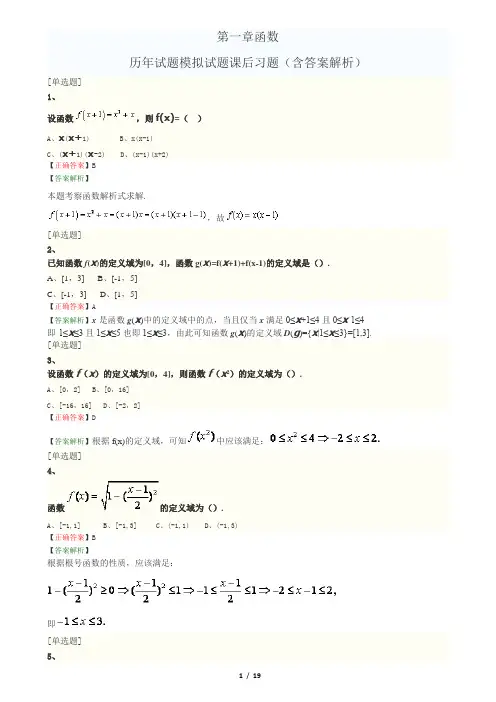
第一章函数历年试题模拟试题课后习题(含答案解析)[单选题]1、设函数,则f(x)=()A、x(x+1)B、x(x-1)C、(x+1)(x-2)D、(x-1)(x+2)【正确答案】B【答案解析】本题考察函数解析式求解.,故[单选题]2、已知函数f(x)的定义域为[0,4],函数g(x)=f(x+1)+f(x-1)的定义域是().A、[1,3]B、[-1,5]C、[-1,3]D、[1,5]【正确答案】A【答案解析】x是函数g(x)中的定义域中的点,当且仅当x满足0≤x+1≤4且0≤x-1≤4即-1≤x≤3且1≤x≤5也即1≤x≤3,由此可知函数g(x)的定义域D(g)={x|1≤x≤3}=[1,3]. [单选题]3、设函数f(x)的定义域为[0,4],则函数f(x2)的定义域为().A、[0,2]B、[0,16]C、[-16,16]D、[-2,2]【正确答案】D【答案解析】根据f(x)的定义域,可知中应该满足:[单选题]4、函数的定义域为().A、[-1,1]B、[-1,3]C、(-1,1)D、(-1,3)【正确答案】B【答案解析】根据根号函数的性质,应该满足:即[单选题]写出函数的定义域及函数值().A、B、C、D、【正确答案】C【答案解析】分段函数的定义域为各个分段区间定义域的并集,故D=(-∞,-1]∪(-1,+∞).[单选题]6、设函数,则对所有的x,则f(-x)=().A、B、C、D、【正确答案】A【答案解析】本题考察三角函数公式。
.[单选题]7、设则=().A、B、C、D、【正确答案】B【答案解析】令则,故[单选题]8、则().A、B、C、D、【正确答案】D【答案解析】[单选题]9、在R上,下列函数中为有界函数的是().xA、eB、1+sin xC、ln x【正确答案】B【答案解析】由函数图像不难看出在R上e x,lnx,tanx都是无界的,只有1+sinx可能有界,由于|sinx|≤1,|1+sinx|≤1+|sinx|≤2所以有界.[单选题]10、不等式的解集为().A、B、C、D、【正确答案】D【答案解析】[单选题]11、().A、B、C、D、【正确答案】A【答案解析】根据二角和公式,[单选题]12、函数的反函数是().A、B、C、D、【正确答案】A【答案解析】由所以,故.[单选题]13、已知则().A、B、C、D、【正确答案】C【答案解析】[单选题]14、已知为等差数列,,则().A、-2B、1C、3D、7【正确答案】A因为同理可得:故d=a4-a3=-2.[单选题]15、计算().A、B、C、D、【正确答案】A【答案解析】根据偶次根式函数的意义,可知,故[单选题]16、计算().A、0B、1C、2D、4【正确答案】C【答案解析】原式=[单选题]将函数|表示为分段函数时,=().A、B、C、D、【正确答案】B【答案解析】由条件[单选题]18、函数f(x)=是().A、奇函数B、偶函数C、有界函数D、周期函数【正确答案】C【答案解析】易知不是周期函数,,即不等于,也不等于,故为非奇、非偶函数.,故为有界函数.[单选题]19、函数,则的定义域为().A、[1,5]C、(1,5]D、[1,5)【正确答案】A【答案解析】由反正切函数的定义域知:,故定义域为[1,5].[单选题]20、下列等式成立的是()A、B、C、D、【正确答案】B【答案解析】A中(e x)2=,C中,D中[单选题]21、下列函数为偶函数的是()A、y=xsinxB、y=xcosxC、y=sinx+cosxD、y=x(sinx+cosx)【正确答案】A【答案解析】sinx是奇函数,cosx是偶函数。
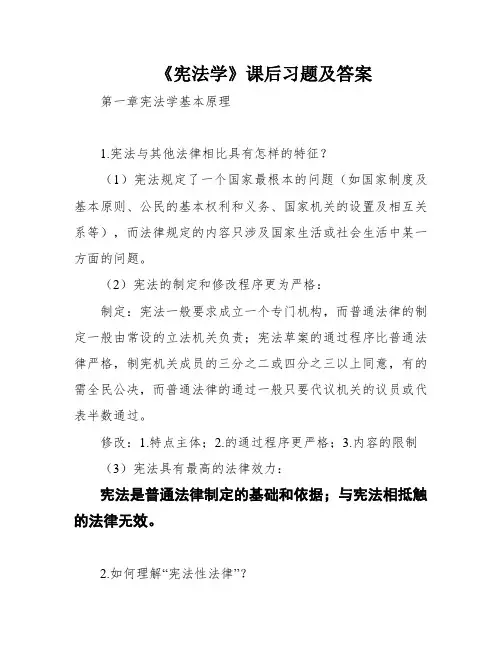
《宪法学》课后习题及答案第一章宪法学基本原理1.宪法与其他法律相比具有怎样的特征?(1)宪法规定了一个国家最根本的问题(如国家制度及基本原则、公民的基本权利和义务、国家机关的设置及相互关系等),而法律规定的内容只涉及国家生活或社会生活中某一方面的问题。
(2)宪法的制定和修改程序更为严格:制定:宪法一般要求成立一个专门机构,而普通法律的制定一般由常设的立法机关负责;宪法草案的通过程序比普通法律严格,制宪机关成员的三分之二或四分之三以上同意,有的需全民公决,而普通法律的通过一般只要代议机关的议员或代表半数通过。
修改:1.特点主体;2.的通过程序更严格;3.内容的限制(3)宪法具有最高的法律效力:宪法是普通法律制定的基础和依据;与宪法相抵触的法律无效。
2.如何理解“宪法性法律”?宪法性法律一般是指有关调整宪法关系内容的法律,是从部门法意义上按法律调整的对象所作的一种学理分类。
两种含义:(1)不成文宪法国家的立法机关制定的调整宪法关系内容的法律。
(一般立法程序、效力与规定其他内容、调整其他社会关系的法律相同)(2)成文宪法国家的立法机关制定的调整宪法关系内容的法律。
(部门法意义上的宪法)作为宪法的表现形式,宪法性法律应当是指不成文宪法国家规定宪法内容、作为宪法构成部分的一系列法律。
宪法性法律仅具有一般法律效率而不具有高于法律的效率。
3.如何理解宪法制定、宪法解释和宪法修改的关系?宪法制定是指宪法制定主体依照一定的理念、基本原则和程序并通过制宪机关创制宪法的活动。
宪法解释是指宪法解释机关根据宪法的基本精神和基本原则对宪法规定的含义、界限及其相互关系所作的具有法律效力的说明。
宪法修改是指宪法修改机关认为宪法的部分内容不适应社会实际而依据宪法规定的特定修改程序删除、增加、变更宪法部分内容的活动。
宪法制定不同于宪法修改,后者是在原有宪法的基础上对宪法内容作全部或部分的变动,但不改变原有宪法的理念和基本原则。
宪法解释和宪法修改都是使原有的宪法规范与社会实际保持一致、协调二者之间关系的方法。
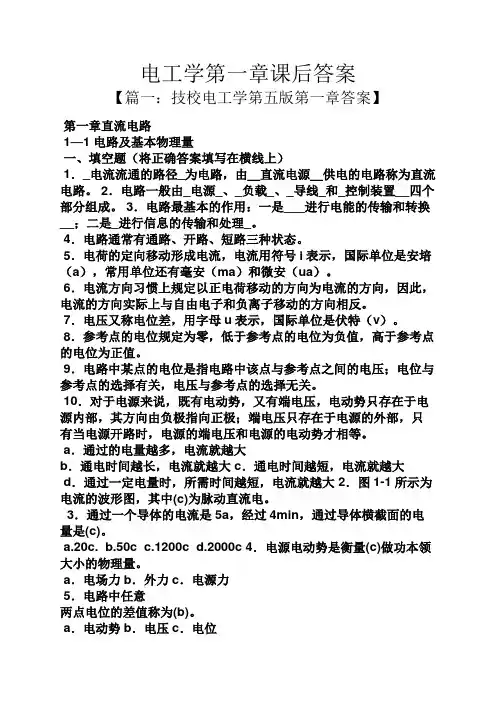
电工学第一章课后答案【篇一:技校电工学第五版第一章答案】第一章直流电路1—1 电路及基本物理量一、填空题(将正确答案填写在横线上)1._电流流通的路径_为电路,由_直流电源_供电的电路称为直流电路。
2.电路一般由_电源_、_负载_、_导线_和_控制装置__四个部分组成。
3.电路最基本的作用:一是___进行电能的传输和转换__;二是_进行信息的传输和处理_。
4.电路通常有通路、开路、短路三种状态。
5.电荷的定向移动形成电流,电流用符号i表示,国际单位是安培(a),常用单位还有毫安(ma)和微安(ua)。
6.电流方向习惯上规定以正电荷移动的方向为电流的方向,因此,电流的方向实际上与自由电子和负离子移动的方向相反。
7.电压又称电位差,用字母u表示,国际单位是伏特(v)。
8.参考点的电位规定为零,低于参考点的电位为负值,高于参考点的电位为正值。
9.电路中某点的电位是指电路中该点与参考点之间的电压;电位与参考点的选择有关,电压与参考点的选择无关。
10.对于电源来说,既有电动势,又有端电压,电动势只存在于电源内部,其方向由负极指向正极;端电压只存在于电源的外部,只有当电源开路时,电源的端电压和电源的电动势才相等。
a.通过的电量越多,电流就越大b.通电时间越长,电流就越大 c.通电时间越短,电流就越大d.通过一定电量时,所需时间越短,电流就越大 2.图1-1所示为电流的波形图,其中(c)为脉动直流电。
3.通过一个导体的电流是5a,经过4min,通过导体横截面的电量是(c)。
a.20c.b.50cc.1200cd.2000c 4.电源电动势是衡量(c)做功本领大小的物理量。
a.电场力b.外力c.电源力5.电路中任意两点电位的差值称为(b)。
a.电动势b.电压c.电位6.电路中任意两点的电压高,则(b)。
a.这两点的电位都高 b.这两点的电位差大 c.这两点的电位都大于零*7.在电路计算时与参考点有关的物理量是(b)。
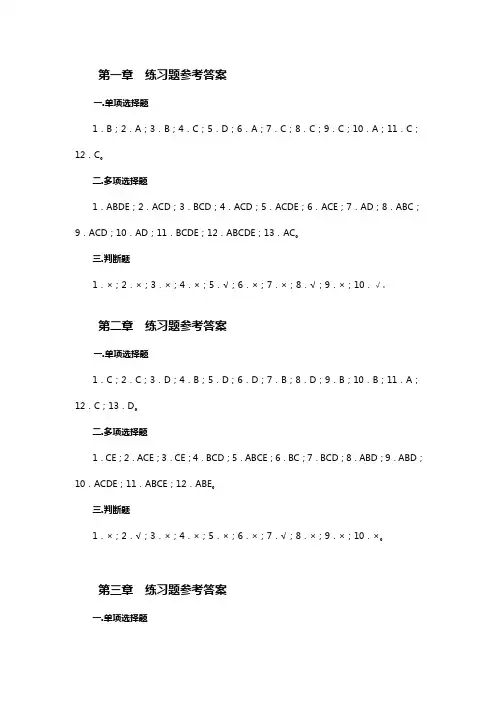
第一章练习题参考答案一.单项选择题1.B;2.A;3.B;4.C;5.D;6.A;7.C;8.C;9.C;10.A;11.C;12.C。
二.多项选择题1.ABDE;2.ACD;3.BCD;4.ACD;5.ACDE;6.ACE;7.AD;8.ABC;9.ACD;10.AD;11.BCDE;12.ABCDE;13.AC。
三.判断题1.×;2.×;3.×;4.×;5.√;6.×;7.×;8.√;9.×;10.√。
第二章练习题参考答案一.单项选择题1.C;2.C;3.D;4.B;5.D;6.D;7.B;8.D;9.B;10.B;11.A;12.C;13.D。
二.多项选择题1.CE;2.ACE;3.CE;4.BCD;5.ABCE;6.BC;7.BCD;8.ABD;9.ABD;10.ACDE;11.ABCE;12.ABE。
三.判断题1.×;2.√;3.×;4.×;5.×;6.×;7.√;8.×;9.×;10.×。
第三章练习题参考答案一.单项选择题1.B;2.C;3.C;4.C;5.D;6.B;7.B;8.B;9.D;10.B;11.A;12.B;13.D;14.A。
二.多项选择题1.AB;2.AC;3.AB;4.ABC;5.AB;6.ABD;7.ABC;8.ACE;9.BD;10.ABDE。
三.判断题1.√;2.×;3.×;4.×;5.√;6.×;7.√;8.√;9.×;10.×。
四.计算分析题1.解:(1)按职称编制的分配数列2.解:编制单项式变量数列3.解:(1)编制组距式变量数列。
(2直方图(略)第四章练习题参考答案一.单项选择题1.C;2.D;3.B;4.D;5.C;6.A;7.C;8.C;9.B;10.C;11.B;12.D;13.A;14.D;15.16.B;17.B;18.D;19.C;20.C;21.D;22.B;23.C;24.C;25.B。

传热学习题集第一章思考题1. 试用简练的语言说明导热、对流换热及辐射换热三种热传递方式之间的联系和区别。
答:导热和对流的区别在于:物体内部依靠微观粒子的热运动而产生的热量传递现象,称为导热;对流则是流体各部分之间发生宏观相对位移及冷热流体的相互掺混。
联系是:在发生对流换热的同时必然伴生有导热。
导热、对流这两种热量传递方式,只有在物质存在的条件下才能实现,而辐射可以在真空中传播,辐射换热时不仅有能 量的转移还伴有能量形式的转换。
2. 以热流密度表示的傅立叶定律、牛顿冷却公式及斯忒藩-玻耳兹曼定律是应当熟记的传热学公式。
试写出这三个公式并说明其中每一个符号及其意义。
答:① 傅立叶定律:,其中,-热流密度;-导热系数;-沿x方向的温度变化率,“-”表示热量传递的方向是沿着温度降低的方向。
② 牛顿冷却公式:,其中,-热流密度;-表面传热系数;-固体表面温度;-流体的温度。
③ 斯忒藩-玻耳兹曼定律:,其中,-热流密度;-斯忒藩-玻耳兹曼常数;-辐射物体的热力学温度。
3. 导热系数、表面传热系数及传热系数的单位各是什么?哪些是物性参数,哪些与过程有关?答:① 导热系数的单位是:W/(m.K);② 表面传热系数的单位是:W/(m 2.K);③ 传热系数的单位是:W/(m 2.K)。
这三个参数中,只有导热系数是物性参数,其它均与过程有关。
4. 当热量从壁面一侧的流体穿过壁面传给另一侧的流体时,冷、热流体之间的换热量可以通过其中任何一个环节来计算(过程是稳态的),但本章中又引入了传热方程式,并说它是“换热器热工计算的基本公式”。
试分析引入传热方程式的工程实用意义。
答:因为在许多工业换热设备中,进行热量交换的冷、热流体也常处于固体壁面的两侧,是工程技术中经常遇到的一种典型热量传递过程。
5. 用铝制的水壶烧开水时,尽管炉火很旺,但水壶仍然安然无恙。
而一旦壶内的水烧干后,水壶很快就烧坏。
试从传热学的观点分析这一现象。
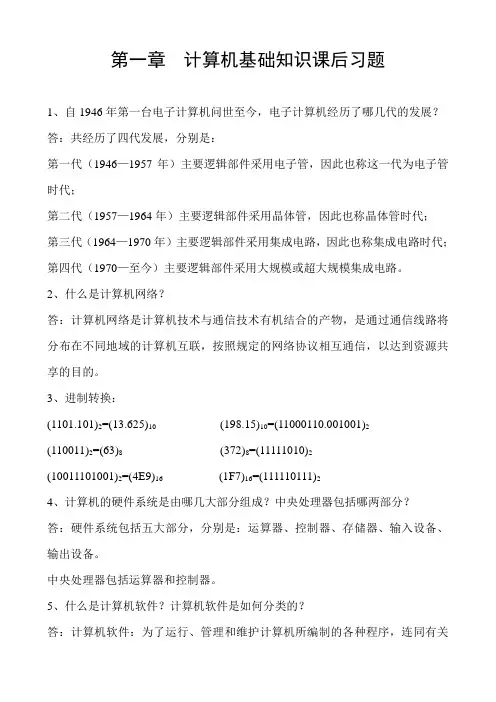
第一章计算机基础知识课后习题1、自1946年第一台电子计算机问世至今,电子计算机经历了哪几代的发展?答:共经历了四代发展,分别是:第一代(1946—1957年)主要逻辑部件采用电子管,因此也称这一代为电子管时代;第二代(1957—1964年)主要逻辑部件采用晶体管,因此也称晶体管时代;第三代(1964—1970年)主要逻辑部件采用集成电路,因此也称集成电路时代;第四代(1970—至今)主要逻辑部件采用大规模或超大规模集成电路。
2、什么是计算机网络?答:计算机网络是计算机技术与通信技术有机结合的产物,是通过通信线路将分布在不同地域的计算机互联,按照规定的网络协议相互通信,以达到资源共享的目的。
3、进制转换:(1101.101)2=(13.625)10(198.15)10=(11000110.001001)2(110011)2=(63)8 (372)8=(11111010)2(10011101001)2=(4E9)16 (1F7)16=(111110111)24、计算机的硬件系统是由哪几大部分组成?中央处理器包括哪两部分?答:硬件系统包括五大部分,分别是:运算器、控制器、存储器、输入设备、输出设备。
中央处理器包括运算器和控制器。
5、什么是计算机软件?计算机软件是如何分类的?答:计算机软件:为了运行、管理和维护计算机所编制的各种程序,连同有关说明资料的总和。
计算机软件分为两大类,分别是:应用软件和系统软件。
6、什么是计算机多媒体及多媒体技术?计算机多媒体系统是如何组成的?答:计算机多媒体:是指使用计算机技术将文字、图形、声音、图像等信息媒体集成到同一个数字化环境中,形成一种人机交互的数字化信息综合媒体。
多媒体技术:是一种基于计算机的处理多种信息媒体的综合技术,主要包括多媒体计算机系统技术、多媒体数据库技术、多媒体通信技术、多媒体人机界面技术和数字化信息技术等。
计算机多媒体系统分为多媒体硬件系统和多媒体软件系统。
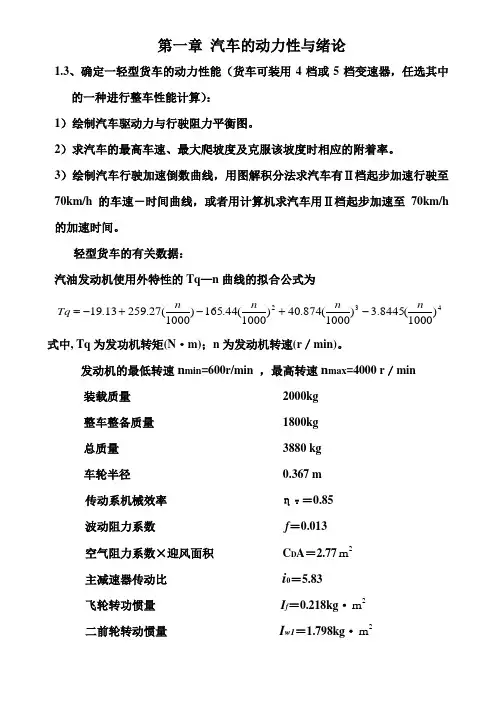
第一章 汽车的动力性与绪论1.3、确定一轻型货车的动力性能(货车可装用4档或5档变速器,任选其中的一种进行整车性能计算): 1)绘制汽车驱动力与行驶阻力平衡图。
2)求汽车的最高车速、最大爬坡度及克服该坡度时相应的附着率。
3)绘制汽车行驶加速倒数曲线,用图解积分法求汽车有Ⅱ档起步加速行驶至70km/h 的车速-时间曲线,或者用计算机求汽车用Ⅱ档起步加速至70km/h 的加速时间。
轻型货车的有关数据:汽油发动机使用外特性的Tq —n 曲线的拟合公式为432)1000(8445.3)1000(874.40)1000(44.165)1000(27.25913.19n n n n Tq -+-+-=式中, Tq 为发功机转矩(N ·m);n 为发动机转速(r /min)。
发动机的最低转速n min =600r/min ,最高转速n max =4000 r /min装载质量 2000kg 整车整备质量 1800kg 总质量 3880 kg 车轮半径 0.367 m传动系机械效率 ηт=0.85 波动阻力系数 f =0.013 空气阻力系数×迎风面积 C D A =2.772m 主减速器传动比 i0=5.83飞轮转功惯量 I f =0.218kg ·2m 二前轮转动惯量 I w1=1.798kg ·2m四后轮转功惯量 I w2=3.598kg ·2m 变速器传动比i g (数据如下表)轴距 L =3.2m质心至前铀距离(满载) α=1.947m质心高(满载) h g =0.9m解答:1)(取四档为例)由uF n u n Tq Tq F t t →⇒⎪⎭⎪⎬⎫→→→ 即ri i T F To g q t η=432)1000(8445.3)1000(874.40)1000(44.165)1000(27.25913.19n n n n Tq -+-+-= og i i rn u 377.0=行驶阻力为w fF F +:215.21a D w f U A C Gf F F +=+ 2131.0312.494aU +=由计算机作图有※本题也可采用描点法做图:由发动机转速在m in /600n min r =,m in /4000n max r =,取六个点分别代入公式:……………………………… 2)⑴最高车速:有w f tF F F +=⇒2131.0312.494a t U F += 分别代入a U 和t F 公式:2)09.6*83.53697.0*377.0(131.0312.494367.085.0*83.5*9.6*n T q +=把q T 的拟和公式也代入可得: n>4000而4000m ax =n r/min∴93.9483.5*0.14000*367.0*377.0max ==U Km/h⑵最大爬坡度:挂Ⅰ档时速度慢,Fw 可忽略:⇒)(max w f t i F F F F +-=⇒GfF Gi t -=max⇒013.08.9*388014400max max-=-=f G F i t=0.366(3)克服该坡度时相应的附着率 zxF F =ϕ忽略空气阻力和滚动阻力得:6.0947.12.3*366.0/=====a il l a i F Fi z ϕ 3)①绘制汽车行驶加速倒数曲线(已装货):40.0626)(1f D g du dt a -==δ(GFwFt D -=为动力因素)Ⅱ时,22022111r i i I m r ImTg f wηδ++=∑2222367.085.0*83.5*09.3*218.038001367.0598.3798.1380011+++= =1.128ri i T F To g q t η=432)1000(8445.3)1000(874.40)1000(44.165)1000(27.25913.19n n n n Tq -+-+-=215.21a D w U A C F =由以上关系可由计算机作出图为:②用计算机求汽车用Ⅳ档起步加速至70km/h 的加速时间。
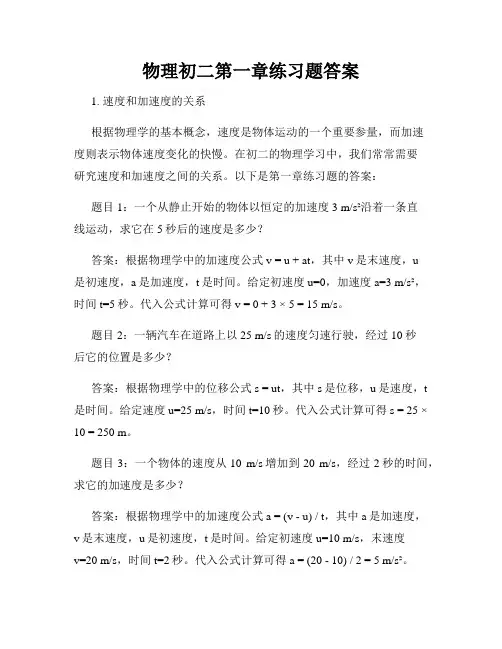
物理初二第一章练习题答案1. 速度和加速度的关系根据物理学的基本概念,速度是物体运动的一个重要参量,而加速度则表示物体速度变化的快慢。
在初二的物理学习中,我们常常需要研究速度和加速度之间的关系。
以下是第一章练习题的答案:题目1:一个从静止开始的物体以恒定的加速度3 m/s²沿着一条直线运动,求它在5秒后的速度是多少?答案:根据物理学中的加速度公式v = u + at,其中v是末速度,u是初速度,a是加速度,t是时间。
给定初速度u=0,加速度a=3 m/s²,时间t=5秒。
代入公式计算可得v = 0 + 3 × 5 = 15 m/s。
题目2:一辆汽车在道路上以25 m/s的速度匀速行驶,经过10秒后它的位置是多少?答案:根据物理学中的位移公式s = ut,其中s是位移,u是速度,t 是时间。
给定速度u=25 m/s,时间t=10秒。
代入公式计算可得s = 25 ×10 = 250 m。
题目3:一个物体的速度从10 m/s增加到20 m/s,经过2秒的时间,求它的加速度是多少?答案:根据物理学中的加速度公式a = (v - u) / t,其中a是加速度,v是末速度,u是初速度,t是时间。
给定初速度u=10 m/s,末速度v=20 m/s,时间t=2秒。
代入公式计算可得a = (20 - 10) / 2 = 5 m/s²。
2. 动量守恒定律在物理学中,动量守恒定律是一个重要的原理,它指出在一个系统内,所有物体的总动量在没有外力作用的情况下保持不变。
以下是第一章练习题中涉及到动量守恒定律的答案:题目1:一辆质量为1000 kg的小轿车以20 m/s的速度向东行驶,和一辆质量为1500 kg的卡车以15 m/s的速度向东行驶发生碰撞,碰撞后两车结合在一起,求结合后的速度是多少?答案:根据动量守恒定律,碰撞前的总动量等于碰撞后的总动量。
小轿车的动量为mv1,卡车的动量为mv2,碰撞后的总动量为(m1 +m2)v。
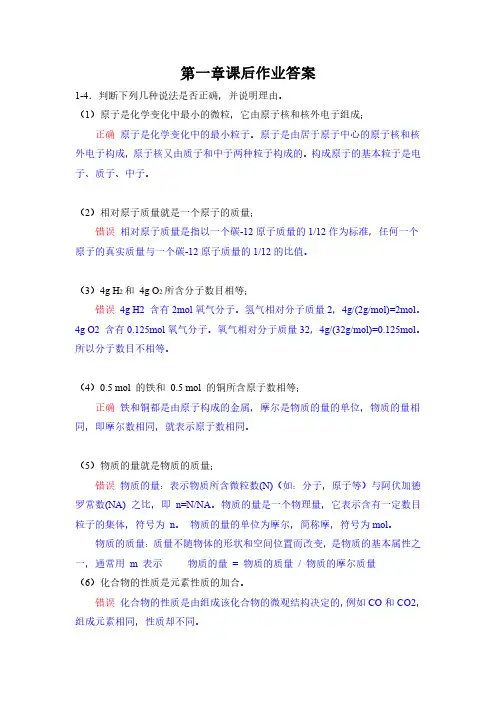
第一章课后作业答案1-4.判断下列几种说法是否正确,并说明理由。
(1)原子是化学变化中最小的微粒,它由原子核和核外电子组成;正确原子是化学变化中的最小粒子。
原子是由居于原子中心的原子核和核外电子构成,原子核又由质子和中子两种粒子构成的。
构成原子的基本粒子是电子、质子、中子。
(2)相对原子质量就是一个原子的质量;错误相对原子质量是指以一个碳-12原子质量的1/12作为标准,任何一个原子的真实质量与一个碳-12原子质量的1/12的比值。
(3)4g H2和4g O2所含分子数目相等;错误4g H2含有2mol氧气分子。
氢气相对分子质量2,4g/(2g/mol)=2mol。
4g O2含有0.125mol氧气分子。
氧气相对分子质量32,4g/(32g/mol)=0.125mol。
所以分子数目不相等。
(4)0.5mol的铁和0.5mol的铜所含原子数相等;正确铁和铜都是由原子构成的金属,摩尔是物质的量的单位,物质的量相同,即摩尔数相同,就表示原子数相同。
(5)物质的量就是物质的质量;错误物质的量:表示物质所含微粒数(N)(如:分子,原子等)与阿伏加德罗常数(NA)之比,即n=N/NA。
物质的量是一个物理量,它表示含有一定数目粒子的集体,符号为n。
物质的量的单位为摩尔,简称摩,符号为mol。
物质的质量:质量不随物体的形状和空间位置而改变,是物质的基本属性之一,通常用m表示物质的量=物质的质量/物质的摩尔质量(6)化合物的性质是元素性质的加合。
错误化合物的性质是由组成该化合物的微观结构决定的,例如CO和CO2,组成元素相同,性质却不同。
1-5.硫酸铵(NH4)2SO4、碳酸氢铵NH4HCO3和尿素CO(NH2)2三种化肥的含氮量各是多少?哪种肥效最高?答:①硫酸铵(NH4)2SO4,含氮量为(14*2)/(14*2+1*8+32*1+16*4)≈0.212②碳酸氢铵NH4HCO3,含氮量为14/(14+1*5+12+16*3)≈0.177③尿素CO(NH2)2,含氮量为(14*2)/(12+16+14*2+1*4)≈0.467综上,0.177<0.212<0.467,这三种肥料中,尿素的含氮量最高,所以尿素的肥效最高。
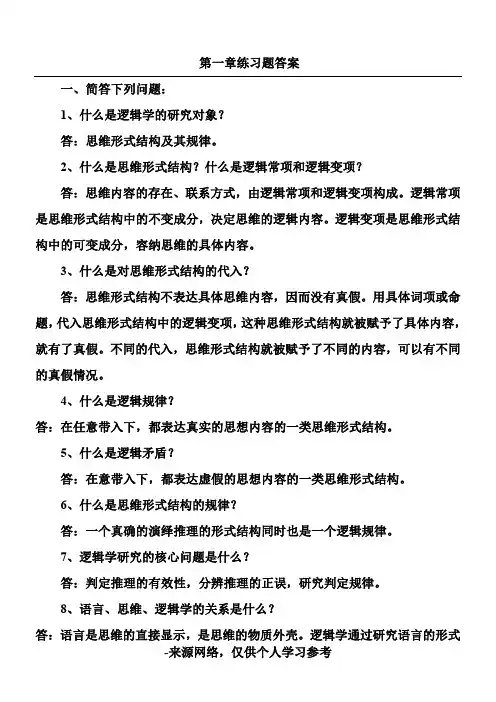
第一章练习题答案一、简答下列问题:1、什么是逻辑学的研究对象?答:思维形式结构及其规律。
2、什么是思维形式结构?什么是逻辑常项和逻辑变项?题,答:一个真确的演绎推理的形式结构同时也是一个逻辑规律。
7、逻辑学研究的核心问题是什么?答:判定推理的有效性,分辨推理的正误,研究判定规律。
8、语言、思维、逻辑学的关系是什么?答:语言是思维的直接显示,是思维的物质外壳。
逻辑学通过研究语言的形式结构,来研究思维的形式结构。
9、语言有哪些构成要素?基本符号(是语言的基本材料,没有基本符号就没有语言),语形规则(什么样的基本符号是合式的,即是本语言中的词、词组或语句、项或公式),语义规则(是对语言中的合式的词、词组或语句的解释,即赋予其意义)。
第二章练习题答案一、判断下列断定的正误:1、对象所具有的性质,统称为对象的属性。
答:错。
因为属性是对象的的性质以及对象间关系的统称。
2、对象的本质属性就是为该类对象共同具有的属性。
答:错。
一类对象共有的属性是固有属性,不一定是本质属性。
指:内涵越少的概念外延越大,内涵越多的概念外延越小。
答:错。
只有具有属种关系的概念外延之间,才存在内涵外延的反变关系。
二、运用本章的相关知识以及相关常识,回答下列问题。
1.“平反就是对处理错误的案件进行纠正。
”错误。
定义过宽。
2.“科学理论就是符合实际的认识。
”错误。
定义过宽。
3.把勇敢限制为“勇敢的战士”。
错误。
“勇敢”和“勇敢的战士”之间不存在属种关系。
4.“喜马拉雅山脉”概括为“珠穆朗玛峰”。
错误。
“喜马拉雅山”和“珠穆朗玛峰”之间不存在属种关系。
三、在以下各句的括号中填入哪个或哪些选项是适当的?2.“《孔乙己》”是单独概念、正概念;“作品”是普遍概念、正概念。
3.“非司机”是普遍概念、负概念。
4.“中国女子排球队”是单独概念、正概念;“世界冠军”是普遍概念、正概念。
5.“中国工人阶级”是单独概念、正概念。
6.“国家检察机关”是单独概念、正概念。
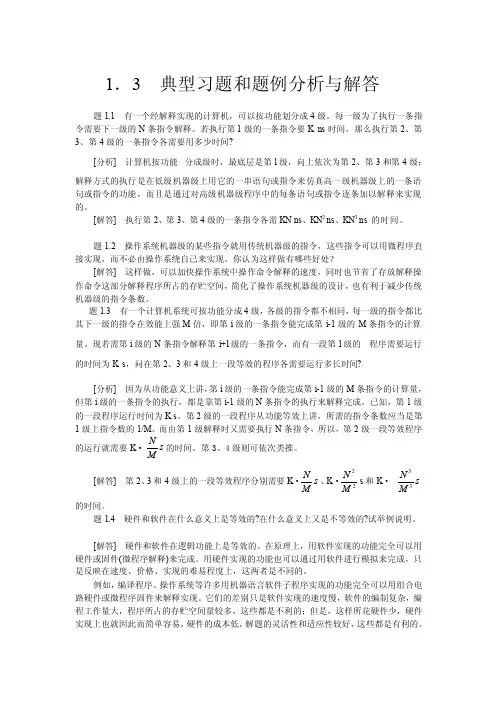
1.3 典型习题和题例分析与解答题1.1 有一个经解释实现的计算机,可以按功能划分成4级。
每一级为了执行一条指令需要下一级的N 条指令解释。
若执行第1级的一条指令要K ns 时间,那么执行第2、第3、第4级的一条指令各需要用多少时间?[分析] 计算机按功能分成级时,最底层是第l 级,向上依次为第2、第3和第4级;解释方式的执行是在低级机器级上用它的一串语句或指令来仿真高一级机器级上的一条语 句或指令的功能,而且是通过对高级机器级程序中的每条语句或指令逐条加以解释来实现的。
[解答] 执行第2、第3、第4级的一条指令各需KN ns 、KN 2 ns 、KN 3 ns 的时间。
题1.2 操作系统机器级的某些指令就用传统机器级的指令,这些指令可以用微程序直接实现,而不必由操作系绕自己来实现。
你认为这样做有哪些好处?[解答] 这样做,可以加快操作系统中操作命令解释的速度,同时也节省了存放解释操作命令这部分解释程序所占的存贮空间,简化了操作系统机器级的设计,也有利于减少传统机器级的指令条数。
题1.3 有一个计算机系统可按功能分成4级,各级的指令都不相同,每一级的指令都比其下一级的指令在效能上强M 倍,即第i 级的一条指令能完成第i-1级的M 条指令的计算量。
现若需第i 级的N 条指令解释第i+l 级的一条指令,而有一段第l 级的程序需要运行的时间为K s ,问在第2、3和4级上一段等效的程序各需要运行多长时间?[分析] 因为从功能意义上讲,第i 级的一条指令能完成第i-1级的M 条指令的计算量,但第i 级的一条指令的执行,都是靠第i-1级的N 条指令的执行来解释完成。
已知,第1级的一段程序运行时间为K s 。
第2级的一段程序从功能等效上讲,所需的指令条数应当是第1级上指令数的1/M 。
而由第1级解释时又需要执行N 条指令,所以,第2级一段等效程序的运行就需要K ·s M N 的时间。
第3、4级则可依次类推。
第一章习题 习题1.11.判断下列函数是否相同: ①定义域不同;②定义域对应法则相同同;2.解 25.125.01)5.0(,2)5.0(=+=-=f f5.解 ① 10,1,1222≤≤-±=-=y y x y x② +∞<<-∞+=+=-=-=y be b c x e c bx c bx e c bx e ay ay a y a y ,,,),ln(ln 6.解 ① x v v u u y sin ,3,ln 2=+== ② 52,arctan 3+==x u u y 习题1.24.解:① 无穷大 ② 无穷小 ③ 负无穷大 ④ 负无穷大 ⑤ 无穷小 ⑥ 无穷小5.求极限:⑴ 21lim 2lim 3)123(lim 13131=+-=+-→→→x x x x x x x⑵ 51)12(lim )3(lim 123lim 22222=+-=+-→→→x x x x x x x⑶ 0tan lim=∞→xxa x⑷-∞=∞--=------=----=+--→→→→32)1)(4(1lim )1)(4()1(2lim )1)(4(122lim 4532lim 11121x x x x x x x x x x x x x x x⑸ 4123lim )2)(2()2)(3(lim 465lim 22222-=+-=-+--=-+-→→→x x x x x x x x x x x x ⑹ )11)(11()11(lim 11lim22220220x x x x x x x x +++-++=+-→→2)11(lim )11(lim 202220-=++-=-++=→→x xx x x x ⑺ 311311lim 131lim 22=++=+++∞→+∞→xx x x x x⑻2132543232lim 25342332lim =⎪⎭⎫⎝⎛⋅+⎪⎭⎫ ⎝⎛⋅+=⋅+⋅⋅+⋅+∞→+∞→x xx x x x x x ⑼ 133)1)(1()2)(1(lim 12lim 1311lim 2132131-=-=+-+-+=+-+=⎪⎭⎫ ⎝⎛+-+-→-→-→x x x x x x x x x x x x x ⑽011lim )1()1)(1(lim)1(lim =++=++++-+=-+∞→∞→∞→nn n n n n n n n n n n n⑾ 1lim 1231lim 22222==⎪⎭⎫ ⎝⎛-+++∞→∞→n n n n n n x x ⑿221121211lim2121211lim 2=-⋅-=⎪⎭⎫ ⎝⎛+++∞→∞→n n n n 6.求极限 ⑴ 414tan lim0=→x x x⑵ 111sinlim1sin lim ==∞→∞→xx x x x x⑶ 2sin 2lim sin sin 2lim sin 2cos 1lim0200===-→→→xxx x x x x x x x x ⑷ x x n nn =⋅∞→2sin 2lim⑸ 21sin lim 212arcsin lim00==→→y y x x y x ⑹111sinlim1sin lim 1sinlim 22222-=-=-=-∞→-∞→-∞→x x x x x x x x x ⑺ k k xx k xx xkx e x x x x ----→---→-→=--=-=-])1()1[(lim )1(lim )1(lim2)(12)(120⑻ 22211lim 1lim e x x x x x xx =⎪⎭⎫ ⎝⎛+=⎪⎭⎫⎝⎛+⋅∞→∞→⑼ 313tan 311cot 0])tan 31()tan 31[(lim )tan 31(lim e x x x xx x x =++=+→+→⑽ =⎪⎭⎫ ⎝⎛-+∞→32321lim x x x 343)34(23])321()321[(lim ---∞→=-⋅-e xx xx ⑾ []1)31(lim )31(lim )31(lim 03133311==+=+=+⋅-+∞→⋅⋅-+∞→-+∞→--e xx x x x x x x x x xxx⑿ 1333111lim 1111lim 1lim -+∞→+∞→+∞→==⎪⎭⎫ ⎝⎛+=⎪⎪⎪⎪⎭⎫⎝⎛+=⎪⎭⎫ ⎝⎛+e ex x x x x x x x x x习题1.31、⑴ 因为函数在x=1点处无定义,)2)(1()1)(1()(--+-=x x x x x f ,但是2)(lim 1-=→x f x ,x=1点是函数的第一类间断点(可去)。
高中数学必修1课后习题答案 第一章 集合与函数概念1.1集合1.1.1集合的含义与表示练习(第5页)1.用符号“∈”或“∉”填空:(1)设A 为所有亚洲国家组成的集合,则:中国_______A ,美国_______A ,印度_______A ,英国_______A ;(2)若2{|}A x x x ==,则1-_______A ; (3)若2{|60}B x x x =+-=,则3_______B ;(4)若{|110}C x N x =∈≤≤,则8_______C ,9.1_______C . 1.(1)中国∈A ,美国∉A ,印度∈A ,英国∉A ;中国和印度是属于亚洲的国家,美国在北美洲,英国在欧洲.(2)1-∉A 2{|}{0,1}A x x x ===.(3)3∉B 2{|60}{3,2}B x x x =+-==-. (4)8∈C ,9.1∉C 9.1N ∉. 2.试选择适当的方法表示下列集合:(1)由方程290x -=的所有实数根组成的集合; (2)由小于8的所有素数组成的集合;(3)一次函数3y x =+与26y x =-+的图象的交点组成的集合; (4)不等式453x -<的解集.2.解:(1)因为方程290x -=的实数根为123,3x x =-=,所以由方程290x -=的所有实数根组成的集合为{3,3}-; (2)因为小于8的素数为2,3,5,7,所以由小于8的所有素数组成的集合为{2,3,5,7};(3)由326y x y x =+⎧⎨=-+⎩,得14x y =⎧⎨=⎩,即一次函数3y x =+与26y x =-+的图象的交点为(1,4),所以一次函数3y x =+与26y x =-+的图象的交点组成的集合为{(1,4)};(4)由453x -<,得2x <,所以不等式453x -<的解集为{|2}x x <.1.1.2集合间的基本关系练习(第7页)1.写出集合{,,}a b c 的所有子集.1.解:按子集元素个数来分类,不取任何元素,得∅;取一个元素,得{},{},{}a b c ; 取两个元素,得{,},{,},{,}a b a c b c ; 取三个元素,得{,,}a b c ,即集合{,,}a b c 的所有子集为,{},{},{},{,},{,},{,},{,,}a b c a b a c b c a b c ∅.2.用适当的符号填空:(1)a ______{,,}a b c ; (2)0______2{|0}x x =; (3)∅______2{|10}x R x ∈+=; (4){0,1}______N ;(5){0}______2{|}x x x =; (6){2,1}______2{|320}x x x -+=.2.(1){,,}a a b c ∈ a 是集合{,,}a b c 中的一个元素;(2)20{|0}x x ∈= 2{|0}{0}x x ==;(3)2{|10}x R x ∅=∈+= 方程210x +=无实数根,2{|10}x R x ∈+==∅;(4){0,1}N (或{0,1}N ⊆) {0,1}是自然数集合N 的子集,也是真子集;(5){0}2{|}x x x = (或2{0}{|}x x x ⊆=) 2{|}{0,1}x x x ==;(6)2{2,1}{|320}x x x =-+= 方程2320x x -+=两根为121,2x x ==.3.判断下列两个集合之间的关系:(1){1,2,4}A =,{|8}B x x =是的约数;(2){|3,}A x x k k N ==∈,{|6,}B x x z z N ==∈;(3){|410}A x x x N +=∈是与的公倍数,,{|20,}B x x m m N +==∈.3.解:(1)因为{|8}{1,2,4,8}B x x ==是的约数,所以AB ;(2)当2k z =时,36k z =;当21k z =+时,363k z =+,即B 是A 的真子集,BA ;(3)因为4与10的最小公倍数是20,所以A B =.1.1.3集合的基本运算练习(第11页)1.设{3,5,6,8},{4,5,7,8}A B ==,求,A B A B .1.解:{3,5,6,8}{4,5,7,8}{5,8}A B ==, {3,5,6,8}{4,5,7,8}{3,4,5,6,7,8}AB ==.2.设22{|450},{|1}A x x x B x x =--===,求,AB A B .2.解:方程2450x x --=的两根为121,5x x =-=, 方程210x -=的两根为121,1x x =-=,得{1,5},{1,1}A B =-=-, 即{1},{1,1,5}AB A B =-=-.3.已知{|}A x x =是等腰三角形,{|}B x x =是直角三角形,求,A B A B .3.解:{|}A B x x =是等腰直角三角形,{|}AB x x =是等腰三角形或直角三角形.4.已知全集{1,2,3,4,5,6,7}U =,{2,4,5},{1,3,5,7}A B ==, 求(),()()U U U AB A B 痧?.4.解:显然{2,4,6}U B =ð,{1,3,6,7}U A =ð, 则(){2,4}U AB =ð,()(){6}U U A B =痧. 1.1集合习题1.1 (第11页) A 组1.用符号“∈”或“∉”填空:(1)237_______Q ; (2)23______N ; (3)π_______Q ;(4_______R ; (5Z ; (6)2_______N .1.(1)237Q ∈ 237是有理数; (2)23N ∈ 239=是个自然数;(3)Q π∉ π是个无理数,不是有理数; (4R(5Z3=是个整数; (6)2N ∈ 2)5=是个自然数.2.已知{|31,}A x x k k Z ==-∈,用 “∈”或“∉” 符号填空: (1)5_______A ; (2)7_______A ; (3)10-_______A . 2.(1)5A ∈; (2)7A ∉; (3)10A -∈. 当2k =时,315k -=;当3k =-时,3110k -=-; 3.用列举法表示下列给定的集合: (1)大于1且小于6的整数; (2){|(1)(2)0}A x x x =-+=; (3){|3213}B x Z x =∈-<-≤.3.解:(1)大于1且小于6的整数为2,3,4,5,即{2,3,4,5}为所求;(2)方程(1)(2)0x x -+=的两个实根为122,1x x =-=,即{2,1}-为所求; (3)由不等式3213x -<-≤,得12x -<≤,且x Z ∈,即{0,1,2}为所求. 4.试选择适当的方法表示下列集合:(1)二次函数24y x =-的函数值组成的集合; (2)反比例函数2y x=的自变量的值组成的集合;(3)不等式342x x ≥-的解集.4.解:(1)显然有20x ≥,得244x -≥-,即4y ≥-,得二次函数24y x =-的函数值组成的集合为{|4}y y ≥-;(2)显然有0x ≠,得反比例函数2y x =的自变量的值组成的集合为{|0}x x ≠; (3)由不等式342x x ≥-,得45x ≥,即不等式342x x ≥-的解集为4{|}5x x ≥.5.选用适当的符号填空:(1)已知集合{|233},{|2}A x x x B x x =-<=≥,则有:4-_______B ; 3-_______A ; {2}_______B ; B _______A ; (2)已知集合2{|10}A x x =-=,则有:1_______A ; {1}-_______A ; ∅_______A ; {1,1}-_______A ; (3){|}x x 是菱形_______{|}x x 是平行四边形; {|}x x 是等腰三角形_______{|}x x 是等边三角形.5.(1)4B -∉; 3A -∉; {2}B ; BA ;2333x x x -<⇒>-,即{|3},{|2}A x x B x x =>-=≥;(2)1A ∈; {1}-A ; ∅A ; {1,1}-=A ; 2{|10}{1,1}A x x =-==-;(3){|}x x 是菱形{|}x x 是平行四边形;菱形一定是平行四边形,是特殊的平行四边形,但是平行四边形不一定是菱形;{|}x x 是等边三角形{|}x x 是等腰三角形.等边三角形一定是等腰三角形,但是等腰三角形不一定是等边三角形.6.设集合{|24},{|3782}A x x B x x x =≤<=-≥-,求,AB A B .6.解:3782x x -≥-,即3x ≥,得{|24},{|3}A x x B x x =≤<=≥, 则{|2}AB x x =≥,{|34}A B x x =≤<.7.设集合{|9}A x x =是小于的正整数,{1,2,3},{3,4,5,6}B C ==,求A B ,AC ,()A B C ,()A B C .7.解:{|9}{1,2,3,4,5,6,7,8}A x x ==是小于的正整数, 则{1,2,3}AB =,{3,4,5,6}AC =, 而{1,2,3,4,5,6}B C =,{3}B C =, 则(){1,2,3,4,5,6}AB C =,(){1,2,3,4,5,6,7,8}A B C =.8.学校里开运动会,设{|}A x x =是参加一百米跑的同学,{|}B x x =是参加二百米跑的同学,{|}C x x =是参加四百米跑的同学,学校规定,每个参加上述的同学最多只能参加两项,请你用集合的语言说明这项规定, 并解释以下集合运算的含义:(1)AB ;(2)A C . 8.解:用集合的语言说明这项规定:每个参加上述的同学最多只能参加两项, 即为()A B C =∅.(1){|}A B x x =是参加一百米跑或参加二百米跑的同学; (2){|}AC x x =是既参加一百米跑又参加四百米跑的同学.9.设{|}S x x =是平行四边形或梯形,{|}A x x =是平行四边形,{|}B x x =是菱形,{|}C x x =是矩形,求BC ,A B ð,S A ð.9.解:同时满足菱形和矩形特征的是正方形,即{|}BC x x =是正方形,平行四边形按照邻边是否相等可以分为两类,而邻边相等的平行四边形就是菱形, 即{|}A B x x =是邻边不相等的平行四边形ð, {|}S A x x =是梯形ð.10.已知集合{|37},{|210}A x x B x x =≤<=<<,求()R AB ð,()R A B ð,()R A B ð,()R A B ð.10.解:{|210}A B x x =<<,{|37}A B x x =≤<,{|3,7}R A x x x =<≥或ð,{|2,10}R B x x x =≤≥或ð, 得(){|2,10}R A B x x x =≤≥或ð, (){|3,7}R A B x x x =<≥或ð, (){|23,710}R A B x x x =<<≤<或ð,(){|2,3710}R AB x x x x =≤≤<≥或或ð.B 组1.已知集合{1,2}A =,集合B 满足{1,2}A B =,则集合B 有 个.1.4 集合B 满足AB A =,则B A ⊆,即集合B 是集合A 的子集,得4个子集.2.在平面直角坐标系中,集合{(,)|}C x y y x ==表示直线y x =,从这个角度看,集合21(,)|45x y D x y x y ⎧-=⎫⎧=⎨⎨⎬+=⎩⎩⎭表示什么?集合,C D 之间有什么关系?2.解:集合21(,)|45x y D x y x y ⎧-=⎫⎧=⎨⎨⎬+=⎩⎩⎭表示两条直线21,45x y x y -=+=的交点的集合,即21(,)|{(1,1)}45x y D x y x y ⎧-=⎫⎧==⎨⎨⎬+=⎩⎩⎭,点(1,1)D 显然在直线y x =上,得D C .3.设集合{|(3)()0,}A x x x a a R =--=∈,{|(4)(1)0}B x x x =--=,求,A B A B .3.解:显然有集合{|(4)(1)0}{1,4}B x x x =--==, 当3a =时,集合{3}A =,则{1,3,4},A B A B ==∅; 当1a =时,集合{1,3}A =,则{1,3,4},{1}A B A B ==; 当4a =时,集合{3,4}A =,则{1,3,4},{4}AB A B ==;当1a ≠,且3a ≠,且4a ≠时,集合{3,}A a =,则{1,3,4,},AB a A B ==∅.4.已知全集{|010}U AB x N x ==∈≤≤,(){1,3,5,7}U A B =ð,试求集合B .4.解:显然{0,1,2,3,4,5,6,7,8,9,10}U =,由U AB =,得U B A ⊆ð,即()U UAB B =痧,而(){1,3,5,7}U A B =ð,得{1,3,5,7}U B =ð,而()U UB B =痧,即{0,2,4,6,8.9,10}B =.第一章 集合与函数概念1.2函数及其表示1.2.1函数的概念练习(第19页)1.求下列函数的定义域:(1)1()47f x x =+; (2)()1f x =.1.解:(1)要使原式有意义,则470x +≠,即74x ≠-,得该函数的定义域为7{|}4x x ≠-;(2)要使原式有意义,则1030x x -≥⎧⎨+≥⎩,即31x -≤≤,得该函数的定义域为{|31}x x -≤≤. 2.已知函数2()32f x x x =+,(1)求(2),(2),(2)(2)f f f f -+-的值; (2)求(),(),()()f a f a f a f a -+-的值.2.解:(1)由2()32f x x x =+,得2(2)322218f =⨯+⨯=,同理得2(2)3(2)2(2)8f -=⨯-+⨯-=,则(2)(2)18826f f +-=+=,即(2)18,(2)8,(2)(2)26f f f f =-=+-=;(2)由2()32f x x x =+,得22()3232f a a a a a =⨯+⨯=+,同理得22()3()2()32f a a a a a -=⨯-+⨯-=-, 则222()()(32)(32)6f a f a a a a a a +-=++-=,即222()32,()32,()()6f a a a f a a a f a f a a =+-=-+-=.3.判断下列各组中的函数是否相等,并说明理由:(1)表示炮弹飞行高度h 与时间t 关系的函数21305h t t =-和二次函数21305y x x =-; (2)()1f x =和0()g x x =.3.解:(1)不相等,因为定义域不同,时间0t >; (2)不相等,因为定义域不同,0()(0)g x x x =≠.1.2.2函数的表示法练习(第23页)1.如图,把截面半径为25cm 的圆形木头锯成矩形木料,如果矩形的一边长为xcm , 面积为2ycm ,把y 表示为x 的函数. 1,y ==,且050x <<,即(050)y x =<<.2.下图中哪几个图象与下述三件事分别吻合得最好?请你为剩下的那个图象写出一件事.(1)我离开家不久,发现自己把作业本忘在家里了,于是返回家里找到了作业本再上学;(2)我骑着车一路匀速行驶,只是在途中遇到一次交通堵塞,耽搁了一些时间; (3)我出发后,心情轻松,缓缓行进,后来为了赶时间开始加速.2.解:图象(A )对应事件(2),在途中遇到一次交通堵塞表示离开家的距离不发生变化;(A )(B )(C )(D )图象(B )对应事件(3),刚刚开始缓缓行进,后来为了赶时间开始加速; 图象(D )对应事件(1),返回家里的时刻,离开家的距离又为零;图象(C )我出发后,以为要迟到,赶时间开始加速,后来心情轻松,缓缓行进. 3.画出函数|2|y x =-的图象.3.解:2,2|2|2,2x x y x x x -≥⎧=-=⎨-+<⎩,图象如下所示.{|},{0,1}A x x B ==是锐角,从A 到B 的映射是“求正弦”,4.设与A 中元素60相对应的B 中的元素是什么?与B 中的元素2相对应的A 中元素是什么?4.解:因为3sin 60=,所以与A 中元素60相对应的B ;因为2sin 452=,所以与B 中的元素2相对应的A 中元素是45. 1.2函数及其表示 习题1.2(第23页)1.求下列函数的定义域:(1)3()4xf x x =-; (2)()f x =(3)26()32f x x x =-+; (4)()1f x x =-.1.解:(1)要使原式有意义,则40x -≠,即4x ≠, 得该函数的定义域为{|4}x x ≠;(2)x R ∈,()f x =即该函数的定义域为R ;(3)要使原式有意义,则2320x x -+≠,即1x ≠且2x ≠,得该函数的定义域为{|12}x x x ≠≠且; (4)要使原式有意义,则4010x x -≥⎧⎨-≠⎩,即4x ≤且1x ≠, 得该函数的定义域为{|41}x x x ≤≠且.2.下列哪一组中的函数()f x 与()g x 相等?(1)2()1,()1x f x x g x x=-=-; (2)24(),()f x x g x ==;(3)2(),()f x x g x ==2.解:(1)()1f x x =-的定义域为R ,而2()1x g x x=-的定义域为{|0}x x ≠, 即两函数的定义域不同,得函数()f x 与()g x 不相等;(2)2()f x x =的定义域为R ,而4()g x =的定义域为{|0}x x ≥,即两函数的定义域不同,得函数()f x 与()g x 不相等;(32x =,即这两函数的定义域相同,切对应法则相同,得函数()f x 与()g x 相等.3.画出下列函数的图象,并说出函数的定义域和值域.(1)3y x =; (2)8y x=; (3)45y x =-+; (4)267y x x =-+. 3.解:(1)定义域是(,)-∞+∞,值域是(,)-∞+∞;(2)定义域是(,0)(0,)-∞+∞,值域是(,0)(0,)-∞+∞;(3)定义域是(,)-∞+∞,值域是(,)-∞+∞;(4)定义域是(,)-∞+∞,值域是[2,)-+∞.4.已知函数2()352f x x x =-+,求(f ,()f a -,(3)f a +,()(3)f a f +.4.解:因为2()352f x x x =-+,所以2(3(5(28f =⨯-⨯+=+即(8f =+同理,22()3()5()2352f a a a a a -=⨯--⨯-+=++,即2()352f a a a -=++;22(3)3(3)5(3)231314f a a a a a +=⨯+-⨯++=++,即2(3)31314f a a a +=++;22()(3)352(3)3516f a f a a f a a +=-++=-+,即2()(3)3516f a f a a +=-+.5.已知函数2()6x f x x +=-, (1)点(3,14)在()f x 的图象上吗?(2)当4x =时,求()f x 的值;(3)当()2f x =时,求x 的值.5.解:(1)当3x =时,325(3)14363f +==-≠-, 即点(3,14)不在()f x 的图象上;(2)当4x =时,42(4)346f +==--, 即当4x =时,求()f x 的值为3-;(3)2()26x f x x +==-,得22(6)x x +=-, 即14x =.6.若2()f x x bx c =++,且(1)0,(3)0f f ==,求(1)f -的值.6.解:由(1)0,(3)0f f ==,得1,3是方程20x bx c ++=的两个实数根,即13,13b c +=-⨯=,得4,3b c =-=,即2()43f x x x =-+,得2(1)(1)4(1)38f -=--⨯-+=, 即(1)f -的值为8.7.画出下列函数的图象:(1)0,0()1,0x F x x ≤⎧=⎨>⎩; (2)()31,{1,2,3}G n n n =+∈.7.图象如下:8.如图,矩形的面积为10,如果矩形的长为x ,宽为y ,对角线为d ,周长为l ,那么你能获得关于这些量的哪些函数?8.解:由矩形的面积为10,即10xy =,得10(0)y x x=>,10(0)x y y =>,由对角线为d ,即d =,得(0)d x =>, 由周长为l ,即22l x y =+,得202(0)l x x x =+>, 另外2()l x y =+,而22210,xy d x y ==+,得(0)l d ===>,即(0)l d =>.9.一个圆柱形容器的底部直径是dcm ,高是hcm ,现在以3/vcm s 的速度向容器内注入某种溶液.求溶液内溶液的高度xcm 关于注入溶液的时间ts 的函数解析式,并写出函数的定义域和值域.9.解:依题意,有2()2dx vt π=,即24v x t d π=,显然0x h ≤≤,即240v t h dπ≤≤,得204h d t v π≤≤, 得函数的定义域为2[0,]4h d vπ和值域为[0,]h . 10.设集合{,,},{0,1}A a b c B ==,试问:从A 到B 的映射共有几个?并将它们分别表示出来.10.解:从A 到B 的映射共有8个.分别是()0()0()0f a f b f c =⎧⎪=⎨⎪=⎩,()0()0()1f a f b f c =⎧⎪=⎨⎪=⎩,()0()1()0f a f b f c =⎧⎪=⎨⎪=⎩,()0()0()1f a f b f c =⎧⎪=⎨⎪=⎩,()1()0()0f a f b f c =⎧⎪=⎨⎪=⎩,()1()0()1f a f b f c =⎧⎪=⎨⎪=⎩,()1()1()0f a f b f c =⎧⎪=⎨⎪=⎩,()1()0()1f a f b f c =⎧⎪=⎨⎪=⎩.B组1.函数()r f p =的图象如图所示.(1)函数()r f p =的定义域是什么?(2)函数()r f p =的值域是什么?(3)r 取何值时,只有唯一的p 值与之对应?1.解:(1)函数()r f p =的定义域是[5,0][2,6)-;(2)函数()r f p =的值域是[0,)+∞;(3)当5r >,或02r ≤<时,只有唯一的p 值与之对应.2.画出定义域为{|38,5}x x x -≤≤≠且,值域为{|12,0}y y y -≤≤≠的一个函数的图象.(1)如果平面直角坐标系中点(,)P x y 的坐标满足38x -≤≤,12y -≤≤,那么其中哪些点不能在图象上?(2)将你的图象和其他同学的相比较,有什么差别吗?2.解:图象如下,(1)点(,0)x 和点(5,)y 不能在图象上;(2)省略.3.函数()[]f x x =的函数值表示不超过x 的最大整数,例如,[ 3.5]4-=-,[2.1]2=.当( 2.5,3]x ∈-时,写出函数()f x 的解析式,并作出函数的图象.3.解:3, 2.522,211,10()[]0,011,122,233,3x x x f x x x x x x --<<-⎧⎪--≤<-⎪⎪--≤<⎪==≤<⎨⎪≤<⎪≤<⎪⎪=⎩图象如下4.如图所示,一座小岛距离海岸线上最近的点P的距离是2km,从点P沿海岸正东12km处有一个城镇.(1)假设一个人驾驶的小船的平均速度为3/km h ,步行的速度是5/km h ,t (单位:h )表示他从小岛到城镇的时间,x (单位:km )表示此人将船停在海岸处距P 点的距离.请将t 表示为x 的函数.(2)如果将船停在距点P 4km 处,那么从小岛到城镇要多长时间(精确到1h )?4.解:(112x -,得1235x t -=+,(012)x ≤≤,即1235x t -=+,(012)x ≤≤.(2)当4x =时,12483()355t h -=+=≈.第一章 集合与函数概念1.3函数的基本性质1.3.1单调性与最大(小)值练习(第32页)1.请根据下图描述某装配线的生产效率与生产线上工人数量间的关系.1.答:在一定的范围内,生产效率随着工人数量的增加而提高,当工人数量达到某个数量时,生产效率达到最大值,而超过这个数量时,生产效率随着工人数量的增加而降低.由此可见,并非是工人越多,生产效率就越高.2.整个上午(8:0012:00)天气越来越暖,中午时分(12:0013:00)一场暴风雨使天气骤然凉爽了许多.暴风雨过后,天气转暖,直到太阳落山(18:00)才又开始转凉.画出这一天8:0020:00期间气温作为时间函数的一个可能的图象,并说出所画函数的单调区间.2.解:图象如下[8,12]是递增区间,[12,13]是递减区间,[13,18]是递增区间,[18,20]是递减区间.3.根据下图说出函数的单调区间,以及在每一单调区间上,函数是增函数还是减函数.3.解:该函数在[1,0]-上是减函数,在[0,2]上是增函数,在[2,4]上是减函数,在[4,5]上是增函数.4.证明函数()21f x x =-+在R 上是减函数.4.证明:设12,x x R ∈,且12x x <,因为121221()()2()2()0f x f x x x x x -=--=->,即12()()f x f x >,所以函数()21f x x =-+在R 上是减函数.5.设()f x 是定义在区间[6,11]-上的函数.如果()f x 在区间[6,2]--上递减,在区间[2,11]-上递增,画出()f x 的一个大致的图象,从图象上可以发现(2)f -是函数()f x 的一个 .5.最小值.1.3.2单调性与最大(小)值练习(第36页)1.判断下列函数的奇偶性:(1)42()23f x x x =+; (2)3()2f x x x =- (3)21()x f x x+=; (4)2()1f x x =+. 1.解:(1)对于函数42()23f x x x =+,其定义域为(,)-∞+∞,因为对定义域内每一个x 都有4242()2()3()23()f x x x x x f x -=-+-=+=,所以函数42()23f x x x =+为偶函数;(2)对于函数3()2f x x x =-,其定义域为(,)-∞+∞,因为对定义域内每一个x 都有33()()2()(2)()f x x x x x f x -=---=--=-,所以函数3()2f x x x =-为奇函数;(3)对于函数21()x f x x+=,其定义域为(,0)(0,)-∞+∞,因为对定义域内 每一个x 都有22()11()()x x f x f x x x-++-==-=--, 所以函数21()x f x x+=为奇函数; (4)对于函数2()1f x x =+,其定义域为(,)-∞+∞,因为对定义域内每一个x 都有22()()11()f x x x f x -=-+=+=,所以函数2()1f x x =+为偶函数.2.已知()f x 是偶函数,()g x 是奇函数,试将下图补充完整.2.解:()f x 是偶函数,其图象是关于y 轴对称的;()g x 是奇函数,其图象是关于原点对称的.习题1.3A 组1.画出下列函数的图象,并根据图象说出函数()y f x =的单调区间,以及在各单调区间上函数()y f x =是增函数还是减函数.(1)256y x x =--; (2)29y x =-. 1.解:(1)函数在5(,)2-∞上递减;函数在5[,)2+∞上递增;(2)函数在(,0)-∞上递增;函数在[0,)+∞上递减.2.证明:(1)函数2()1f x x =+在(,0)-∞上是减函数;(2)函数1()1f x x=-在(,0)-∞上是增函数. 2.证明:(1)设120x x <<,而2212121212()()()()f x f x x x x x x x -=-=+-,由12120,0x x x x +<-<,得12()()0f x f x ->,即12()()f x f x >,所以函数2()1f x x =+在(,0)-∞上是减函数;(2)设120x x <<,而1212211211()()x x f x f x x x x x --=-=, 由12120,0x x x x >-<,得12()()0f x f x -<,即12()()f x f x <,所以函数1()1f x x=-在(,0)-∞上是增函数. 3.探究一次函数()y mx b x R =+∈的单调性,并证明你的结论.3.解:当0m >时,一次函数y mx b =+在(,)-∞+∞上是增函数;当0m <时,一次函数y mx b =+在(,)-∞+∞上是减函数,令()f x mx b =+,设12x x <,而1212()()()f x f x m x x -=-,当0m >时,12()0m x x -<,即12()()f x f x <,得一次函数y mx b =+在(,)-∞+∞上是增函数;当0m <时,12()0m x x ->,即12()()f x f x >,得一次函数y mx b =+在(,)-∞+∞上是减函数.4.一名心率过速患者服用某种药物后心率立刻明显减慢,之后随着药力的减退,心率再次慢慢升高.画出自服药那一刻起,心率关于时间的一个可能的图象(示意图).4.解:自服药那一刻起,心率关于时间的一个可能的图象为5.某汽车租赁公司的月收益y 元与每辆车的月租金x 元间的关系为21622100050x y x =-+-,那么,每辆车的月租金多少元时,租赁公司的月收益最大?最大月收益是多少?5.解:对于函数21622100050x y x =-+-, 当162405012()50x =-=⨯-时,max 307050y =(元), 即每辆车的月租金为4050元时,租赁公司最大月收益为307050元.6.已知函数()f x 是定义在R 上的奇函数,当0x ≥时,()(1)f x x x =+.画出函数()f x的图象,并求出函数的解析式.6.解:当0x <时,0x ->,而当0x ≥时,()(1)f x x x =+,即()(1)f x x x -=--,而由已知函数是奇函数,得()()f x f x -=-,得()(1)f x x x -=--,即()(1)f x x x =-,所以函数的解析式为(1),0()(1),0x x x f x x x x +≥⎧=⎨-<⎩.B 组1.已知函数2()2f x x x =-,2()2([2,4])g x x x x =-∈.(1)求()f x ,()g x 的单调区间; (2)求()f x ,()g x 的最小值.1.解:(1)二次函数2()2f x x x =-的对称轴为1x =,则函数()f x 的单调区间为(,1),[1,)-∞+∞,且函数()f x 在(,1)-∞上为减函数,在[1,)+∞上为增函数,函数()g x 的单调区间为[2,4],且函数()g x 在[2,4]上为增函数;(2)当1x =时,min ()1f x =-,因为函数()g x 在[2,4]上为增函数,所以2min ()(2)2220g x g ==-⨯=.2.如图所示,动物园要建造一面靠墙的2间面积相同的矩形熊猫居室,如果可供建造围墙的材料总长是30m ,那么宽x (单位:m )为多少才能使建造的每间熊猫居室面积最大?每间熊猫居室的最大面积是多少?2.解:由矩形的宽为x m ,得矩形的长为3032x m -,设矩形的面积为S , 则23033(10)22x x x S x --==-, 当5x =时,2max 37.5S m =,即宽5x =m 才能使建造的每间熊猫居室面积最大,且每间熊猫居室的最大面积是18.75m^2.3.已知函数()f x 是偶函数,而且在(0,)+∞上是减函数,判断()f x 在(,0)-∞上是增函数还是减函数,并证明你的判断.3.判断()f x 在(,0)-∞上是增函数,证明如下:设120x x <<,则120x x ->->,因为函数()f x 在(0,)+∞上是减函数,得12()()f x f x -<-,又因为函数()f x 是偶函数,得12()()f x f x <,所以()f x 在(,0)-∞上是增函数.复习参考题A 组1.用列举法表示下列集合:(1)2{|9}A x x ==;(2){|12}B x N x =∈≤≤;(3)2{|320}C x x x =-+=.1.解:(1)方程29x =的解为123,3x x =-=,即集合{3,3}A =-; (2)12x ≤≤,且x N ∈,则1,2x =,即集合{1,2}B =;(3)方程2320x x -+=的解为121,2x x ==,即集合{1,2}C =.2.设P 表示平面内的动点,属于下列集合的点组成什么图形?(1){|}P PA PB =(,)A B 是两个定点;(2){|3}P PO cm =()O 是定点.2.解:(1)由PA PB =,得点P 到线段AB 的两个端点的距离相等,即{|}P PA PB =表示的点组成线段AB 的垂直平分线;(2){|3}P PO cm =表示的点组成以定点O 为圆心,半径为3cm 的圆.3.设平面内有ABC ∆,且P 表示这个平面内的动点,指出属于集合{|}{|}P PA PB P PA PC ==的点是什么.3.解:集合{|}P PA PB =表示的点组成线段AB 的垂直平分线,集合{|}P PA PC =表示的点组成线段AC 的垂直平分线,得{|}{|}P PA PB P PA PC ==的点是线段AB 的垂直平分线与线段AC 的垂直平分线的交点,即ABC ∆的外心.4.已知集合2{|1}A x x ==,{|1}B x ax ==.若B A ⊆,求实数a 的值.4.解:显然集合{1,1}A =-,对于集合{|1}B x ax ==,当0a =时,集合B =∅,满足B A ⊆,即0a =;当0a ≠时,集合1{}B a =,而B A ⊆,则11a =-,或11a =, 得1a =-,或1a =,综上得:实数a 的值为1,0-,或1.5.已知集合{(,)|20}A x y x y =-=,{(,)|30}B x y x y =+=,{(,)|23}C x y x y =-=,求A B ,A C ,()()A B B C .5.解:集合20(,)|{(0,0)}30x y A B x y x y ⎧-=⎫⎧==⎨⎨⎬+=⎩⎩⎭,即{(0,0)}A B =;集合20(,)|23x y AC x y x y ⎧-=⎫⎧==∅⎨⎨⎬-=⎩⎩⎭,即A C =∅; 集合3039(,)|{(,)}2355x y B C x y x y ⎧+=⎫⎧==-⎨⎨⎬-=⎩⎩⎭; 则39()(){(0,0),(,)}55A B B C =-. 6.求下列函数的定义域:(1)y =(2)||5y x =-. 6.解:(1)要使原式有意义,则2050x x -≥⎧⎨+≥⎩,即2x ≥, 得函数的定义域为[2,)+∞;(2)要使原式有意义,则40||50x x -≥⎧⎨-≠⎩,即4x ≥,且5x ≠,得函数的定义域为[4,5)(5,)+∞. 7.已知函数1()1x f x x-=+,求:(1)()1(1)f a a +≠-; (2)(1)(2)f a a +≠-.7.解:(1)因为1()1x f x x-=+, 所以1()1a f a a -=+,得12()1111a f a a a-+=+=++, 即2()11f a a+=+; (2)因为1()1x f x x-=+, 所以1(1)(1)112a a f a a a -++==-+++, 即(1)2a f a a +=-+. 8.设221()1x f x x+=-,求证:50 (1)()()f x f x -=; (2)1()()f f x x=-. 8.证明:(1)因为221()1x f x x+=-, 所以22221()1()()1()1x x f x f x x x+-+-===---, 即()()f x f x -=;(2)因为221()1x f x x+=-, 所以222211()11()()111()x x f f x x x x++===---, 即1()()f f x x=-. 9.已知函数2()48f x x kx =--在[5,20]上具有单调性,求实数k 的取值范围.9.解:该二次函数的对称轴为8k x =, 函数2()48f x x kx =--在[5,20]上具有单调性, 则208k ≥,或58k ≤,得160k ≥,或40k ≤, 即实数k 的取值范围为160k ≥,或40k ≤.10.已知函数2y x -=,(1)它是奇函数还是偶函数?(2)它的图象具有怎样的对称性?(3)它在(0,)+∞上是增函数还是减函数?(4)它在(,0)-∞上是增函数还是减函数?10.解:(1)令2()f x x -=,而22()()()f x x x f x ---=-==,即函数2y x -=是偶函数;(2)函数2y x -=的图象关于y 轴对称;(3)函数2y x -=在(0,)+∞上是减函数;(4)函数2y x -=在(,0)-∞上是增函数.B 组1.学校举办运动会时,高一(1)班共有28名同学参加比赛,有15人参加游泳比赛,有8人参加田径比赛,有14人参加球类比赛,同时参加游泳比赛和田径比赛的有3人,同时参加游泳比赛和球类比赛的有3人,没有人同时参加三项比赛.问同时参加田径和球类比赛的有多少人?只参加游泳一项比赛的有多少人?1.解:设同时参加田径和球类比赛的有x 人,则158143328x ++---=,得3x =,只参加游泳一项比赛的有15339--=(人),即同时参加田径和球类比赛的有3人,只参加游泳一项比赛的有9人.2.已知非空集合2{|}A x R x a =∈=,试求实数a 的取值范围.2.解:因为集合A ≠∅,且20x ≥,所以0a ≥.3.设全集{1,2,3,4,5,6,7,8,9}U =,(){1,3}U AB =ð,(){2,4}U A B =ð,求集合B . 3.解:由(){1,3}U AB =ð,得{2,4,5,6,7,8,9}A B =, 集合A B 里除去()U A B ð,得集合B ,所以集合{5,6,7,8,9}B =.4.已知函数(4),0()(4),0x x x f x x x x +≥⎧=⎨-<⎩.求(1)f ,(3)f -,(1)f a +的值. 4.解:当0x ≥时,()(4)f x x x =+,得(1)1(14)5f =⨯+=;当0x <时,()(4)f x x x =-,得(3)3(34)21f -=-⨯--=;(1)(5),1(1)(1)(3),1a a a f a a a a ++≥-⎧+=⎨+-<-⎩. 5.证明:(1)若()f x ax b =+,则1212()()()22x x f x f x f ++=; (2)若2()g x x ax b =++,则1212()()()22x x g x g x g ++≤. 5.证明:(1)因为()f x ax b =+,得121212()()222x x x x a f a b x x b ++=+=++, 121212()()()222f x f x ax b ax b a x x b ++++==++, 所以1212()()()22x x f x f x f ++=; (2)因为2()g x x ax b =++, 得22121212121()(2)()242x x x x g x x x x a b ++=++++, 22121122()()1[()()]22g x g x x ax b x ax b +=+++++ 2212121()()22x x x x a b +=+++, 因为2222212121212111(2)()()0424x x x x x x x x ++-+=--≤, 即222212121211(2)()42x x x x x x ++≤+, 所以1212()()()22x x g x g x g ++≤. 6.(1)已知奇函数()f x 在[,]a b 上是减函数,试问:它在[,]b a --上是增函数还是减函数?(2)已知偶函数()g x 在[,]a b 上是增函数,试问:它在[,]b a --上是增函数还是减函数?6.解:(1)函数()f x 在[,]b a --上也是减函数,证明如下:设12b x x a -<<<-,则21a x x b <-<-<,因为函数()f x 在[,]a b 上是减函数,则21()()f x f x ->-,又因为函数()f x 是奇函数,则21()()f x f x ->-,即12()()f x f x >,所以函数()f x 在[,]b a --上也是减函数;(2)函数()g x 在[,]b a --上是减函数,证明如下:设12b x x a -<<<-,则21a x x b <-<-<,因为函数()g x 在[,]a b 上是增函数,则21()()g x g x -<-,又因为函数()g x 是偶函数,则21()()g x g x <,即12()()g x g x >,所以函数()g x 在[,]b a --上是减函数. 7.《中华人民共和国个人所得税》规定,公民全月工资、薪金所得不超过2000元的部分不必纳税,超过2000元的部分为全月应纳税所得额.此项税款按下表分段累计计算:某人一月份应交纳此项税款为26.78元,那么他当月的工资、薪金所得是多少?7.解:设某人的全月工资、薪金所得为x 元,应纳此项税款为y 元,则0,02000(2000)5%,2000250025(2500)10%,25004000175(4000)15%,40005000x x x y x x x x ≤≤⎧⎪-⨯<≤⎪=⎨+-⨯<≤⎪⎪+-⨯<≤⎩由该人一月份应交纳此项税款为26.78元,得25004000x <≤,25(2500)10%26.78x +-⨯=,得2517.8x =,所以该人当月的工资、薪金所得是2517.8元.第三章函数的应用3.1函数与方程练习(P88)1.(1)令f(x)=-x2+3x+5,作出函数f(x)的图象(图3-1-2-7(1)),它与x轴有两个交点,所以方程-x2+3x+5=0有两个不相等的实数根.(2)2x(x-2)=-3可化为2x2-4x+3=0,令f(x)=2x2-4x+3,作出函数f(x)的图象(图3-1-2-7(2)),它与x轴没有交点,所以方程2x(x-2)=-3无实数根.(3)x2=4x-4可化为x2-4x+4=0,令f(x)=x2-4x+4,作出函数f(x)的图象(图3-1-2-7(3)),它与x轴只有一个交点(相切),所以方程x2=4x-4有两个相等的实数根.(4)5x2+2x=3x2+5可化为2x2+2x-5=0,令f(x)=2x2+2x-5,作出函数f(x)的图象(图3-1-2-7(4)),它与x轴有两个交点,所以方程5x2+2x=3x2+5有两个不相等的实数根.图3-1-2-72.(1)作出函数图象(图3-1-2-8(1)),因为f(1)=1>0,f(1.5)=-2.875<0,所以f(x)=-x3-3x+5在区间(1,1.5)上有一个零点.又因为f(x)是(-∞,+∞)上的减函数,所以f(x)=-x3-3x+5在区间(1,1.5)上有且只有一个零点.(2)作出函数图象(图3-1-2-8(2)),因为f(3)<0,f(4)>0,所以f(x)=2x·ln(x-2)-3在区间(3,4)上有一个零点.又因为f(x)=2x·ln(x-2)-3在(2,+∞)上是增函数,所以f(x)在(3,4)上有且仅有一个零点.(3)作出函数图象(图3-1-2-8(3)),因为f(0)<0,f(1)>0,所以f(x)=e x-1+4x-4在区间(0,1)上有一个零点.又因为f(x)=e x-1+4x-4在(-∞,+∞)上是增函数,所以f(x)在(0,1)上有且仅有一个零点.(4)作出函数图象(图3-1-2-8(4)),因为f(-4)<0,f(-3)>0,f(-2)<0,f(2)<0,f(3)>0,所以f(x)=3(x+2)(x-3)(x+4)+x在(-4,-3),(-3,-2),(2,3)上各有一个零点.图3-1-2-8练习(P91)1.由题设可知f(0)=-1.4<0,f(1)=1.6>0,于是f(0)·f(1)<0,所以函数f(x)在区间(0,1)内有一个零点x0.下面用二分法求函数f(x)=x3+1.1x2+0.9x-1.4在区间(0,1)内的零点.取区间(0,1)的中点x1=0.5,用计算器可算得f(0.5)=-0.55.因为f(0.5)·f(1)<0,所以x0∈(0.5,1).再取区间(0.5,1)的中点x2=0.75,用计算器可算得f(0.75)≈0.32.因为f(0.5)·f(0.75)<0,所以x0∈(0.5,0.75).同理,可得x0∈(0.625,0.75),x0∈(0.625,0.687 5),x0∈(0.656 25,0.687 5).由于|0.687 5-0.656 25|=0.031 25<0.1,所以原方程的近似解可取为0.656 25.2.原方程可化为x+lgx-3=0,令f(x)=x+lgx-3,用计算器可算得f(2)≈-0.70,f(3)≈0.48.于是f(2)·f(3)<0,所以这个方程在区间(2,3)内有一个解x0.下面用二分法求方程x=3-lgx在区间(2,3)的近似解.取区间(2,3)的中点x1=2.5,用计算器可算得f(2.5)≈-0.10.因为f(2.5)·f(3)<0,所以x0∈(2.5,3).再取区间(2.5,3)的中点x2=2.75,用计算器可算得f(2.75)≈0.19.因为f(2.5)·f(2.75)<0,所以x0∈(2.5,2.75).同理,可得x0∈(2.5,2.625),x0∈(2.562 5,2.625),x0∈(2.562 5,2.593 75),x0∈(2.578 125,2.593 75),x0∈(2.585 937 5,2.59 375).由于|2.585 937 5-2.593 75|=0.007 812 5<0.01,所以原方程的近似解可取为2.593 75.习题3.1 A组(P92)1.A,C 点评:需了解二分法求函数的近似零点的条件.2.由x,f(x)的对应值表可得f(2)·f(3)<0,f(3)·f(4)<0,f(4)·f(5)<0,又根据“如果函数y=f(x)在区间[a,b]上的图象是连续不断的一条曲线,并且f(a)·f(b)<0,那么函数y=f(x)在区间(a,b)内有零点.”可知函数f(x)分别在区间(2,3),(3,4),(4,5)内有零点.3.原方程即(x+1)(x-2)(x-3)-1=0,令f(x)=(x+1)(x-2)(x-3)-1,可算得f(-1)=-1,f(0)=5.于是f(-1)·f(0)<0,所以这个方程在区间(-1,0)内有一个解. 下面用二分法求方程(x+1)(x-2)(x-3)=1在区间(-1,0)内的近似解.取区间(-1,0)的中点x1=-0.5,用计算器可算得f(-0.5)=3.375.因为f(-1)·f(-0.5)<0,所以x0∈(-1,-0.5).再取(-1,-0.5)的中点x2=-0.75,用计算器可算得f(-0.75)≈1.58.因为f(-1)·f(-0.75)<0,所以x0∈(-1,-0.75).同理,可得x0∈(-1,-0.875),x0∈(-0.937 5,-0.875).由于|(-0.875)-(-0.937 5)|=0.062 5<0.1,所以原方程的近似解可取为-0.937 5.4.原方程即0.8x-1-lnx=0,令f(x)=0.8x-1-lnx,f(0)没有意义,用计算器算得f(0.5)≈0.59,f(1)=-0.2.于是f(0.5)·f(1)<0,所以这个方程在区间(0.5,1)内有一个解.下面用二分法求方程0.8x-1=lnx在区间(0,1)内的近似解.取区间(0.5,1)的中点x1=0.75,用计算器可算得f(0.75)≈0.13.因为f (0.75)·f (1)<0,所以x 0∈(0.75,1).再取(0.75,1)的中点x 2=0.875,用计算器可算得f (0.875)≈-0.04.因为f (0.875)·f (0.75)<0,所以x 0∈(0.75,0.875).同理,可得x 0∈(0.812 5,0.875),x 0∈(0.812 5,0.843 75).由于|0.812 5-0.843 75|=0.031 25<0.1,所以原方程的近似解可取为0.843 75.5.由题设有f (2)≈-0.31<0,f (3)≈0.43>0,于是f (2)·f (3)<0,所以函数f (x )在区间(2,3)内有一个零点.下面用二分法求函数f (x )=lnx x2-在区间(2,3)内的近似解. 取区间(2,3)的中点x 1=2.5,用计算器可算得f (2.5)≈0.12.因为f (2)·f (2.5)<0,所以x 0∈(2,2.5).再取(2,2.5)的中点x 2=2.25,用计算器可算得f (2.25)≈-0.08.因为f (2.25)·f (2.5)<0,所以x 0∈(2.25,2.5).同理,可得x 0∈(2.25,2.375),x 0∈(2.312 5,2.375),x 0∈(2.343 75,2.375),x 0∈(2.343 75,2.359 375),x 0∈(2.343 75,2.351 562 5),x 0∈(2.343 75,2.347 656 25).由于|2.343 75-2.347 656 25|=0.003 906 25<0.01,所以原方程的近似解可取为2.347 656 25.B 组1.将系数代入求根公式x 得x =223(3)42(1)22±--⨯⨯-⨯=4173+, 所以方程的两个解分别为x 1=4173+,x 2=4173-.下面用二分法求方程的近似解.取区间(1.775,1.8)和(-0.3,-0.275),令f (x )=2x 2-3x -1.在区间(1.775,1.8)内用计算器可算得f (1.775)=-0.023 75,f (1.8)=0.08.于是f (1.775)·f (1.8)<0.所以这个方程在区间(1.775,1.8)内有一个解.由于|1.8-1.775|=0.025<0.1,所以原方程在区间(1.775,1.8)内的近似解可取为1.8.同理,可得方程在区间(-0.3,-0.275)内的近似解可取为-0.275.所以方程精确到0.1的近似解分别是1.8和-0.3.2.原方程即x3-6x2-3x+5=0,令f(x)=x3-6x2-3x+5,函数图象如下图所示.图3-1-2-9所以这个方程在区间(-2,0),(0,1),(6,7)内各有一个解.取区间(-2,0)的中点x1=-1,用计算器可算得f(-1)=1.因为f(-2)·f(-1)<0,所以x0∈(-2,-1).再取(-2,-1)的中点x2=-1.5,用计算器可算得f(-1.5)=-7.375.因为f(-1.5)·f(-1)<0,所以x0∈(-1.5,-1).同理,可得x0∈(-1.25,-1),x0∈(-1.125,-1),x0∈(-1.125,-1.062 5).由于|(-1.062 5)-(-1.125)|=0.062 5<0.1,所以原方程在区间(-2,0)内的近似解可取为-1.062 5.同理,可得原方程在区间(0,1)内的近似解可取为0.7,在区间(6,7)内的近似解可取为6.3.3.(1)由题设有g(x)=2-[f(x)]2=2-(x2+3x+2)2=-x4-6x3-13x2-12x-2.(2)函数图象如下图所示.图3-1-2-10(3)由图象可知,函数g(x)分别在区间(-3,-2)和区间(-1,0)内各有一个零点.取区间(-3,-2)的中点x1=-2.5,用计算器可算得g(-2.5)=0.187 5.因为g(-3)·g(-2.5)<0,所以x0∈(-3,-2.5).再取(-3,-2.5)的中点x2=-2.75,用计算器可算得g(-2.75)≈0.28.因为g(-3)·g(-2.75)<0,所以x0∈(-3,-2.75).同理,可得x0∈(-2.875,-2.75),x0∈(-2.812 5,-2.75).由于|-2.75-(-2.812 5)|=0.062 5<0.1,所以原方程在区间(-3,-2)内的近似解可取为-2.812 5.同样可求得函数在区间(-1,0)内的零点约为-0.2.所以函数g(x)精确到0.1的零点约为-2.8或-0.2.点评:第2、3题采用信息技术画出函数图象,并据此明确函数零点所在的区间.在教学中,如果没有信息技术条件,建议教师直接给出函数图象或零点所在区间.第三章复习参考题A组(P112)1.C2.C3.设经过时间t后列车离C地的距离为y,则y=200100,02,100200,2 5.t tt t-≤≤⎧⎨-<≤⎩图3-24.(1)圆柱形; (2)上底小、下底大的圆台形;(3)上底大、下底小的圆台形; (4)呈下大上小的两节圆柱形. 图略.图3-35.令f(x)=2x3-4x2-3x+1,函数图象如图3-3所示:函数分别在区间(-1,0)、(0,1)和区间(2,3)内各有一个零点,所以方程2x3-4x2-3x+1=0的最大的根应在区间(2,3)内.取区间(2,3)的中点x1=2.5,用计算器可算得f(2.5)=-0.25.因为f(2.5)·f(3)<0,所以x0∈(2.5,3). 再取(2.5,3)的中点x2=2.75,用计算器可算得f(2.75)≈4.09.因为f(2.5)·f(2.75)<0,所以x0∈(2.5,2.75).同理,可得x0∈(2.5,2.625),x0∈(2.5,2.5625),x0∈(2.5,2.53125),x0∈(2.515625,2.53125),x0∈(2.515625,2.5234375).由于|2.523 437 5-2.515 625|=0.007 812 5<0.01,所以原方程的最大根约为2.523 437 5.6.令lgx =x 1,即得方程lgx x 1-=0,再令g (x )=lgx x1-,用二分法求得交点的横坐标约为2.5.图3-47.如图,作DE ⊥AB,垂足为E.由已知可得∠ADB=90°.因为AD=x ,AB=4,于是AD 2=AE×AB,即AE=AB AD 2=42x . 所以CD=AB-2AE=4-2×42x =422x -. 于是y =AB+BC+CD+AD=4+x +422x -+x =22x -+2x +8. 由于AD>0,AE>0,CD>0,所以x >0,42x >0,422x ->0,解得0<x <22. 所以所求的函数为y =22x -+2x +8,0<x <22. 8.(1)由已知可得N=N 0(λe 1)t .因为λ是正常数,e >1,所以e λ>1,即0<λe1<1. 又N 0是正常数,所以N=N 0(λe1)t 是在于t 的减函数. (2)N=N 0e -λt ,因为e -λt =0N N ,所以-λt =ln 0N N ,即t =λ1-ln 0N N . (3)当N=20N 时,t =λ1-002N N =λ1-ln 2. 9.因为f (1)=-3+12+8=17>0,f (2)=-3×8+12×2+8=8>0,f (3)<0,所以,下次生产应在两个月后开始.B 组1.厂商希望的是甲曲线;客户希望的是乙曲线.2.函数的解析式为y=f(t)=22,01, 2(2)12,22.tt tt<≤⎪⎪⎪⎪--+<≤⎨>⎪⎩函数的图象为图3-5备课资料[备选例题]【例】对于函数f(x)=ax2+(b+1)x+b-2(a≠0),若存在实数x0,使f(x0)=x0成立,则称x0为f(x)的不动点.(1)当a=2,b=-2时,求f(x)的不动点;(2)若对于任何实数b,函数f(x)恒有两个相异的不动点,求实数a的取值范围.解:(1)f(x)=ax2+(b+1)x+b-2(a≠0),当a=2,b=-2时,f(x)=2x2-x-4,设x为其不动点,即2x2-x-4=x,则2x2-2x-4=0,解得x1=-1,x2=2,即f(x)的不动点为-1,2.(2)由f(x)=x,得ax2+bx+b-2=0.关于x的方程有相异实根,则b2-4a(b-2)>0,即b2-4ab+8a>0.又对所有的b∈R,b2-4ab+8a>0恒成立,故有(4a)2-4·8a<0,得0<a<2.。
第一章 绪论1.1 扼要归纳典型的以离子键形成的化合物与以共价键形成的化合物的物理性质。
1.2是否相同?如将CH 4 及CCl 4各1mol 混在一起,与CHCl 3及CH 3Cl 各1mol 的混合物是否相同?为什么?答案: NaCl 与KBr 各1mol 与NaBr 及KCl 各1mol 溶于水中所得溶液相同。
因为两者溶液中均为Na + , K + , Br -, Cl -离子各1mol 。
由于CH 4 与CCl 4及CHCl 3与CH 3Cl 在水中是以分子状态存在,所以是两组不同的混合物。
1.3 碳原子核外及氢原子核外各有几个电子?它们是怎样分布的?画出它们的轨道形状。
当四个氢原子与一个碳原子结合成甲烷(CH 4)时,碳原子核外有几个电子是用来与氢成键的?画出它们的轨道形状及甲烷分子的形状。
答案:C+624HCCH 4中C 中有4个电子与氢成键为SP 3杂化轨道,正四面体结构CH 4SP 3杂化2p y2p z2p x2sH1.4 写出下列化合物的Lewis 电子式。
a. C 2H 4b. CH 3Clc. NH 3d. H 2Se. HNO 3f. HCHOg. H 3PO 4h. C 2H 6i. C 2H 2 j. H 2SO 4 答案:a.C C H H H HCC HH HH或 b.H C H H c.H N HHd.H S He.H O NO f.O C H Hg.O P O O H H Hh.H C C HHH H HO P O O H HH或i.H C C Hj.O S O HH OH H或1.5 下列各化合物哪个有偶极矩?画出其方向。
a. I 2b. CH 2Cl 2c. HBrd. CHCl 3e. CH 3OHf. CH 3OCH 3 答案:b.ClClc.HBrd.HCe.H 3COHH 3COCH 3f.1.6 根据S 与O 的电负性差别,H 2O 与H 2S 相比,哪个有较强的偶极-偶极作用力或氢键?答案:电负性 O > S , H 2O 与H 2S 相比,H 2O 有较强的偶极作用及氢键。
大学课程《人工智能》课后答案第一章课后习题1、对N=5、k≤3时,求解传教士和野人问题的产生式系统各组成部分进行描述(给出综合数据库、规则集合的形式化描述,给出初始状态和目标条件的描述),并画出状态空间图。
2、对量水问题给出产生式系统描述,并画出状态空间图。
有两个无刻度标志的水壶,分别可装5升和2升的水。
设另有一水缸,可用来向水壶灌水或倒出水,两个水壶之间,水也可以相互倾灌。
已知5升壶为满壶,2升壶为空壶,问如何通过倒水或灌水操作,使能在2升的壶中量出一升的水来。
3、对梵塔问题给出产生式系统描述,并讨论N为任意时状态空间的规模。
相传古代某处一庙宇中,有三根立柱,柱子上可套放直径不等的N个圆盘,开始时所有圆盘都放在第一根柱子上,且小盘处在大盘之上,即从下向上直径是递减的。
和尚们的任务是把所有圆盘一次一个地搬到另一个柱子上去(不许暂搁地上等),且小盘只许在大盘之上。
问和尚们如何搬法最后能完成将所有的盘子都移到第三根柱子上(其余两根柱子,有一根可作过渡盘子使用)。
求N=2时,求解该问题的产生式系统描述,给出其状态空间图。
讨论N为任意时,状态空间的规模。
4、对猴子摘香蕉问题,给出产生式系统描述。
一个房间里,天花板上挂有一串香蕉,有一只猴子可在房间里任意活动(到处走动,推移箱子,攀登箱子等)。
设房间里还有一只可被猴子移动的箱子,且猴子登上箱子时才能摘到香蕉,问猴子在某一状态下(设猴子位置为a,箱子位置为b,香蕉位置为c),如何行动可摘取到香蕉。
5、对三枚钱币问题给出产生式系统描述及状态空间图。
设有三枚钱币,其排列处在"正、正、反"状态,现允许每次可翻动其中任意一个钱币,问只许操作三次的情况下,如何翻动钱币使其变成"正、正、正"或"反、反、反"状态。
6、说明怎样才能用一个产生式系统把十进制数转换为二进制数,并通过转换141.125这个数为二进制数,阐明其运行过程。
第1章课后习题参考题答案第⼀章半导体器件基础1.试求图所⽰电路的输出电压Uo,忽略⼆极管的正向压降和正向电阻。
解:(a)图分析:1)若D1导通,忽略D1的正向压降和正向电阻,得等效电路如图所⽰,则U O=1V,U D2=1-4=-3V。
即D1导通,D2截⽌。
2)若D2导通,忽略D2的正向压降和正向电阻,得等效电路如图所⽰,则U O=4V,在这种情况下,D1两端电压为U D1=4-1=3V,远超过⼆极管的导通电压,D1将因电流过⼤⽽烧毁,所以正常情况下,不因出现这种情况。
综上分析,正确的答案是 U O= 1V。
(b)图分析:1.由于输出端开路,所以D1、D2均受反向电压⽽截⽌,等效电路如图所⽰,所以U O=U I=10V。
2.图所⽰电路中,E解:由于Eu oE u i3.选择正确的答案填空在图所⽰电路中,电阻R为6Ω,⼆极管视为理想元件。
当普通指针式万⽤表置于R×1Ω挡时,⽤⿊表笔(通常带正电)接A点,红表笔(通常带负电)接B点,则万⽤表的指⽰值为( a )。
a.l8Ω,b.9Ω,c.3Ω,d.2Ω,e.0Ω解:由于A端接电源的正极,B端接电源的负极,所以两只⼆极管都截⽌,相当于断开,等效电路如图,正确答案是18Ω。
4.在图所⽰电路中,uI =10sinωt V,E = 5V,⼆极管的正向压降可忽略不计,试分别画出输出电压uo的波形。
解:(a )图当u I <E 时,D 截⽌,u O =E=5V ;当u I ≥E 时,D 导通,u O =u I u O 波形如图所⽰。
(b )图当u I <-E=-5V 时,D 1导通D 2截⽌,uo=E=5V ;当-E <u I <E 时,D 1导通D 2截⽌,uo=E=5V ;当u I ≥E=5V 时,uo=u I所以输出电压u o 的波形与(a )图波形相同。
5.在图所⽰电路中,试求下列⼏种情况下输出端F 的电位UF 及各元件(R 、DA 、DB)中通过的电流:( 1 )UA=UB=0V ;( 2 )UA= +3V ,UB = 0 V 。
第一章1.(Q1) What is the difference between a host and an end system List the types of endsystems. Is a Web server an end systemAnswer: There is no difference. Throughout this text, the words “host” and “end system” are used interchangeably. End systems include PCs, workstations, Web servers, mail servers, Internet-connected PDAs, WebTVs, etc.2.(Q2) The word protocol is often used to describe diplomatic relations. Give an example of adiplomatic protocol.Answer: Suppose Alice, an ambassador of country A wants to invite Bob, an ambassador of country B, over for dinner. Alice doesn’t simply just call Bob on the phone and say, come to our dinner table now”. Instead, she calls Bob and suggests a date and time. Bob may respond by saying he’s not available that p articular date, but he is available another date. Alice and Bob continue to send “messages” back and forth until they agree on a date and time. Bob then shows up at the embassy on the agreed date, hopefully not more than 15 minutes before or after the agreed time. Diplomatic protocols also allow for either Alice or Bob to politely cancel the engagement if they have reasonable excuses.3.(Q3) What is a client program What is a server program Does a server program request andreceive services from a client programAnswer: A networking program usually has two programs, each running on a different host, communicating with each other. The program that initiates the communication is the client.Typically, the client program requests and receives services from the server program.4.(Q4) List six access technologies. Classify each one as residential access, company access, ormobile access.Answer:1. Dial-up modem over telephone line: residential; 2. DSL over telephone line: residential or small office; 3. Cable to HFC: residential; 4. 100 Mbps switched Etherent: company; 5. Wireless LAN: mobile; 6. Cellular mobile access (for example, 3G/4G): mobile5.(Q5) List the available residential access technologies in your city. For each type of access,provide the advertised downstream rate, upstream rate, and monthly price.Answer: Current possibilities include: dial-up (up to 56kbps); DSL (up to 1 Mbps upstream, up to 8 Mbps downstream); cable modem (up to 30Mbps downstream, 2 Mbps upstream.6.(Q7) What are some of the physical media that Ethernet can run overAnswer: Ethernet most commonly runs over twisted-pair copper wire and “thin” coaxial cable. It also can run over fibers optic links and thick coaxial cable.7.(Q8) Dial-up modems, HFC, and DSL are all used for residential access. For each of theseaccess technologies, provide a range of transmission rates and comment on whether the transmission rate is shared or dedicated.Answer:Dial up modems: up to 56 Kbps, bandwidth is dedicated; ISDN: up to 128 kbps, bandwidth is dedicated; ADSL: downstream channel is .5-8 Mbps, upstream channel is up to1 Mbps, bandwidth is dedicated; HFC, downstream channel is 10-30 Mbps and upstreamchannel is usually less than a few Mbps, bandwidth is shared.8.(Q13) Why is it said that packet switching employs statistical multiplexing Contraststatistical multiplexing with the multiplexing that takes place in TDM.Answer: In a packet switched network, the packets from different sources flowing on a link do not follow any fixed, pre-defined pattern. In TDM circuit switching, each host gets the same slot in a revolving TDM frame.9.(Q14) Suppose users share a 2Mbps link. Also suppose each user requires 1Mbps whentransmitting, but each user transmits only 20 percent of the time. (See the discussion of statistical multiplexing in Section .)a.When circuit switching is used, how many users can be supportedb.For the remainder of this problem, suppose packet switching is used. Why will there beessentially no queuing delay before the link if two or fewer users transmit at the same time Why will there be a queuing delay if three users transmit at the same timec.Find the probability that a given user is transmitting.d.Suppose now there are three users. Find the probability that at any given time, allthree users are transmitting simultaneously. Find the fraction of time during which the queue grows.Answer:a. 2 users can be supported because each user requires half of the link bandwidth.b.Since each user requires 1Mbps when transmitting, if two or fewer users transmitsimultaneously, a maximum of 2Mbps will be required. Since the available bandwidth of the shared link is 2Mbps, there will be no queuing delay before the link. Whereas, if three users transmit simultaneously, the bandwidth required will be 3Mbps which is more than the available bandwidth of the shared link. In this case, there will be queuing delay before the link.c.Probability that a given user is transmitting =d.Probability that all three users are transmittingsimultaneously. Since the queue grows when all the usersare transmitting, the fraction of time during which the queue grows (which is equal to the probability that all three users are transmitting simultaneously) is .10.(Q16) Consider sending a packet from a source host to a destination host over a fixed route.List the delay components in the end-to-end delay. Which of these delays are constant and which are variableAnswer:The delay components are processing delays, transmission delays, propagation delays, and queuing delays. All of these delays are fixed, except for the queuing delays, which are variable.11.(Q19) Suppose Host A wants to send a large file to Host B. The path from Host A to Host Bhas three links, of rates R1 = 250 kbps, R2 = 500 kbps, and R3 = 1 Mbps.a.Assuming no other traffic in the network, what is the throughput for the file transfer.b.Suppose the file is 2 million bytes. Roughly, how long will it take to transfer the file toHost Bc.Repeat (a) and (b), but now with R2 reduced to 200 kbps.Answer:a.250 kbpsb.64 secondsc.200 kbps; 80 seconds12.(P2) Consider the circuit-switched network in Figure . Recall that there are n circuits oneach link.a.What is the maximum number of simultaneous connections that can be in progress atany one time in this networkb.Suppose that all connections are between the switch in the upper-left-hand cornerand the switch in the lower-right-hand corner. What is the maximum number ofsimultaneous connections that can be in progressAnswer:a.We can n connections between each of the four pairs of adjacent switches. This gives amaximum of 4n connections.b.We can n connections passing through the switch in the upper-right-hand corner andanother n connections passing through the switch in the lower-left-hand corner, giving a total of 2n connections.13.(P4) Review the car-caravan analogy in Section . Assume a propagation speed of 50km/hour.a.Suppose the caravan travels 150 km, beginning in front of one tollbooth, passingthrough a second tollbooth, and finishing just before a third tollbooth. What is theend-to-end delayb.Repeat (a), now assuming that there are five cars in the caravan instead of ten.Answer: Tollbooths are 150 km apart, and the cars propagate at 50 km/hr, A tollbooth services a car at a rate of one car every 12 seconds.a.There are ten cars. It takes 120 seconds, or two minutes, for the first tollbooth to servicethe 10 cars. Each of these cars has a propagation delay of 180 minutes before arriving at the second tollbooth. Thus, all the cars are lined up before the second tollbooth after 182 minutes. The whole process repeats itself for traveling between the second and third tollbooths. Thus the total delay is 364 minutes.b.Delay between tollbooths is 5*12 seconds plus 180 minutes, ., 181minutes. The totaldelay is twice this amount, ., 362 minutes.14.(P5) This elementary problem begins to explore propagation delay and transmission delay,two central concepts in data networking. Consider two hosts, A and B, connected by a single link of rate R bps. Suppose that the two hosts are separated by m meters, and suppose the propagation speed along the link is s meters/sec. Host A is to send a packet of size L bits to Host B.a.Express the propagation delay, d prop , in terms of m and s.b.Determine the transmission time of the packet, d trans , in terms of L and R.c.Ignoring processing and queuing delays, obtain an expression for the end-to-enddelay.d.Suppose Host A begins to transmit the packet at time t = 0. At time t = d trans , where isthe last bit of the packete.Suppose d prop is greater than d trans . At time t = d trans , where is the first bit of thepacketf.Suppose d prop is less than d trans . At time t = d trans , where is the first bit of the packetg.Suppose s = *108, L = 100bits, and R = 28kbps. Find the distance m so that d prop equalsd trans .Answer:a. d prop = m/s seconds.b. d trans = L/R seconds.c. d end-to-end = (m/s + L/R) seconds.d.The bit is just leaving Host A.e.The first bit is in the link and has not reached Host B.f.The first bit has reached Host B.g.Want15.(P6) In this problem we consider sending real-time voice from Host A to Host B over apacket-switched network (VoIP). Host A converts analog voice to a digital 64 kbps bit stream on the fly. Host A then groups the bits into 56-Byte packets. There is one linkbetween Host A and B; its transmission rate is 500 kbps and its propagation delay is 2 msec.As soon as Host A gathers a packet, it sends it to Host B. As soon as Host B receives an entire packet, it converts the packet’s bits to an analog signal. How much time elapses from the time a bit is created (from the original analog signal at Host A) until the bit is decoded (as part of the analog signal at Host B)Answer: Consider the first bit in a packet. Before this bit can be transmitted, all of the bits in the packet must be generated. This requiresThe time required to transmit the packet isPropagation delay = 2 msec.The delay until decoding is7msec + 896μsec + 2msec = msecA similar analysis shows that all bits experience a delay of msec.16.(P9) Consider a packet of length L which begins at end system A, travels over one link to apacket switch, and travels from the packet switch over a second link to a destination end system. Let d i, s i, and R i denote the length, propagation speed, and the transmission rate of link i, for i= 1, 2. The packet switch delays each packet by d proc. Assuming no queuing delays, in terms of d i, s i, R i, (i= 1, 2), and L, what is the total end-to-end delay for the packet Suppose now the packet Length is 1,000 bytes, the propagation speed on both links is * 108 m/s, the transmission rates of both links is 1 Mbps, the packet switch processing delay is 2 msec, the length of the first link is 6,000 km, and the length of the last link is 3,000 km. For these values, what is the end-to-end delayAnswer: The first end system requires L/R1to transmit the packet onto the first link; the packet propagates over the first link in d1/s1; the packet switch adds a processing delay ofd proc; after receiving the entire packet, the packet switch requires L/R2to transmit the packetonto the second link; the packet propagates over the second link in d2/s2. Adding these five delays givesd end-end = L/R1 + L/R2 + d1/s1 + d2/s2 + d procTo answer the second question, we simply plug the values into the equation to get 8 + 8 +24 + 12 + 2 = 54 msec.17.(P10) In the above problem, suppose R1 = R2 = R and d proc= 0. Further suppose the packetswitch does not store-and-forward packets but instead immediately transmits each bit it receivers before waiting for the packet to arrive. What is the end-to-end delayAnswer: Because bits are immediately transmitted, the packet switch does not introduce any delay; in particular, it does not introduce a transmission delay. Thus,d end-end = L/R + d1/s1 + d2/s2For the values in Problem 9, we get 8 + 24 + 12 = 44 msec.18.(P11) Suppose N packets arrive simultaneously to a link at which no packets are currentlybeing transmitted or queued. Each packet is of length L and the link has transmission rate R.What is the average queuing delay for the N packetsAnswer:The queuing delay is 0 for the first transmitted packet, L/R for the second transmitted packet, and generally, (n-1)L/R for the nth transmitted packet. Thus, the average delay for the N packets is(L/R + 2L/R + ....... + (N-1)L/R)/N = L/RN(1 + 2 + ..... + (N-1)) = LN(N-1)/(2RN) = (N-1)L/(2R) Note that here we used the well-known fact that1 +2 + ....... + N = N(N+1)/219.(P14) Consider the queuing delay in a router buffer. Let I denote traffic intensity; that is, I =La/R. Suppose that the queuing delay takes the form IL/R (1-I) for I<1.a.Provide a formula for the total delay, that is, the queuing delay plus the transmissiondelay.b.Plot the total delay as a function of L/R.Answer:a.The transmission delay is L / R . The total delay isb.Let x = L / R.20.(P16) Perform a Traceroute between source and destination on the same continent at threedifferent hours of the day.a.Find the average and standard deviation of the round-trip delays at each of the threehours.b.Find the number of routers in the path at each of the three hours. Did the pathschange during any of the hoursc.Try to identify the number of ISP networks that the Traceroute packets pass throughfrom source to destination. Routers with similar names and/or similar IP addresses should be considered as part of the same ISP. In your experiments, do the largest delays occur at the peering interfaces between adjacent ISPsd.Repeat the above for a source and destination on different continents. Compare theintra-continent and inter-continent results.Answer: Experiments.21.(P18) Suppose two hosts, A and B, are separated by 10,000 kilometers and are connectedby a direct link of R = 2 Mbps. Suppose the propagation speed over the link is 108 meters/sec.a.Calculate the bandwidth-delay product, R d prop.b.Consider sending a file of 400,000 bits from Host A to Host B. Suppose the file is sentcontinuously as one large message. What is the maximum number of bits that will be in the link at any given timec.Provide an interpretation of the bandwidth-delay product.d.What is the width (in meters) of a bit in the link Is it longer than a football fielde.Derive a general expression for the width of a bit in terms of the propagation speed s,the transmission rate R, and the length of the link m.Answer:a.d prop = 107 / 108 = sec; so R d prop = 80,000bitsb.80,000bitsc.The bandwidth-delay product of a link is the maximum number of bits that can be in thelink.d. 1 bit is 125 meters long, which is longer than a football fielde.m / (R d prop ) = m / (R * m / s) = s/R22.(P20) Consider problem P18 but now with a link of R = 1 Gbps.a.Calculate the bandwidth-delay product, R·d prop .b.Consider sending a file of 400,000 bits from Host A to Host B. Suppose the file is sentcontinuously as one big message. What is the maximum number of bits that will be inthe link at any given timec.What is the width (in meters) of a bit in the linkAnswer:a.40,000,000 bits.b.400,000 bits.c.meters.23.(P21) Refer again to problem P18.a.How long does it take to send the file, assuming it is sent continuouslyb.Suppose now the file is broken up into 10 packet is acknowledged by the receiver andthe transmission time of an acknowledgment packet is negligible. Finally, assumethat the sender cannot send a packet until the preceding one is acknowledged. Howlong does it take to send the filepare the results from (a) and (b).Answer:a. d trans + d prop = 200 msec + 40 msec = 240 msecb.10 * (t trans + 2 t prop ) = 10 * (20 msec + 80 msec) = sec。